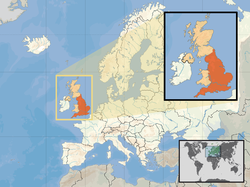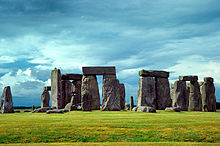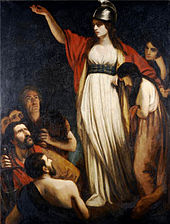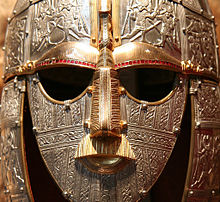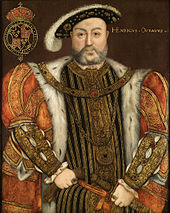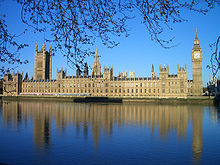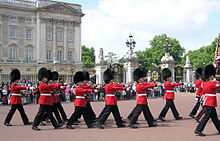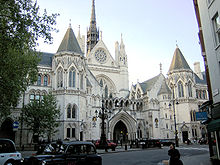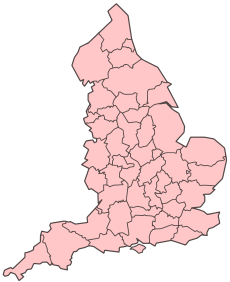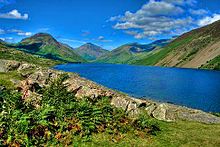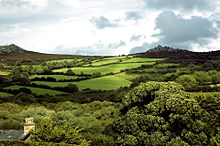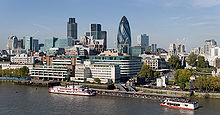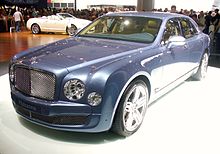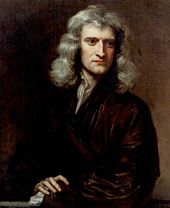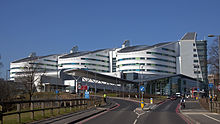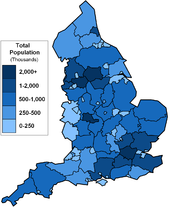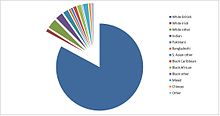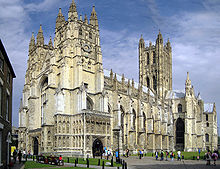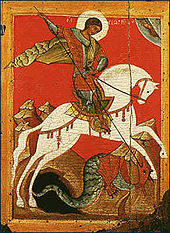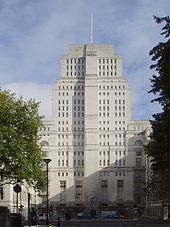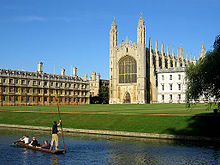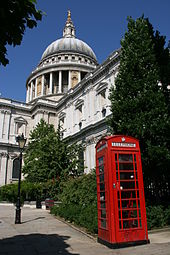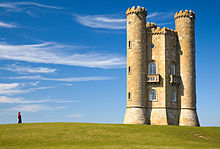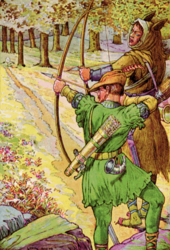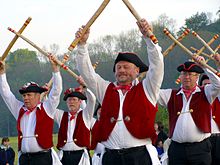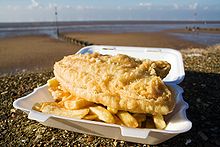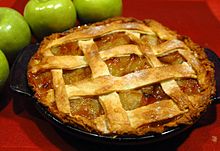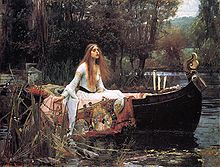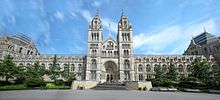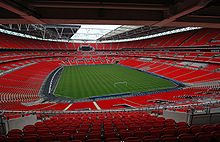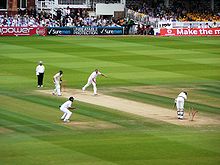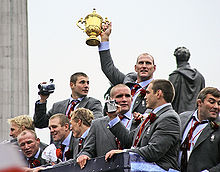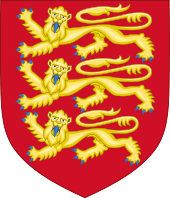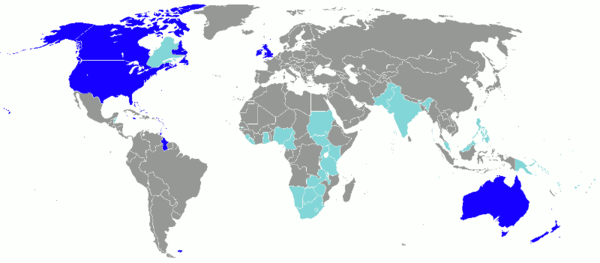- England
-
England 

Flag Royal Banner Motto: Dieu et mon droit (French)
"God and my right"[1][2]Anthem: None (de jure)
God Save the Queen (de facto)Location of England (orange)– in the European continent (camel & white)
– in the United Kingdom (camel)Capital
(and largest city)London
51°30′N 0°7′W / 51.5°N 0.117°WOfficial language(s) English (de facto)[note 1] Recognised regional languages Cornish Ethnic groups (2009
[3][4])87.5% White, 6.0% South Asian, 2.9% Black, 1.9% Mixed race, 0.8% Chinese, 0.8% Other Demonym English Government Non-devolved state within a constitutional monarchy - Monarch Elizabeth II - Prime Minister of the United Kingdom David Cameron MP Legislature Parliament of the United Kingdom Area - Total 130,395 km2
50,346 sq miPopulation - 2008 estimate 51,446,000[5] - 2001 census 49,138,831 - Density 395/km2
1,023/sq miCurrency Pound sterling ( GBP)Time zone GMT (UTC0) - Summer (DST) BST (UTC+1) Date formats dd/mm/yyyy (AD) Drives on the left ISO 3166 code GB Internet TLD .uk[note 2] Calling code 44 Patron saint Saint George England
 i/ˈɪŋɡlənd/ is a country that is part of the United Kingdom.[6][7][8] It shares land borders with Scotland to the north and Wales to the west; the Irish Sea is to the north west, the Celtic Sea to the south west, with the North Sea to the east and the English Channel to the south separating it from continental Europe. Most of England comprises the central and southern part of the island of Great Britain in the North Atlantic. The country also includes over 100 smaller islands such as the Isles of Scilly and the Isle of Wight.
i/ˈɪŋɡlənd/ is a country that is part of the United Kingdom.[6][7][8] It shares land borders with Scotland to the north and Wales to the west; the Irish Sea is to the north west, the Celtic Sea to the south west, with the North Sea to the east and the English Channel to the south separating it from continental Europe. Most of England comprises the central and southern part of the island of Great Britain in the North Atlantic. The country also includes over 100 smaller islands such as the Isles of Scilly and the Isle of Wight.The area now called England was first inhabited by modern humans during the Upper Palaeolithic period, but it takes its name from the Angles, one of the Germanic tribes who settled during the 5th and 6th centuries. England became a unified state in AD 927, and since the Age of Discovery, which began during the 15th century, has had a significant cultural and legal impact on the wider world.[9] The English language, the Anglican Church, and English law—the basis for the common law legal systems of many other countries around the world—developed in England, and the country's parliamentary system of government has been widely adopted by other nations.[10] The Industrial Revolution began in 18th-century England, transforming its society into the world's first industrialised nation.[11] England's Royal Society laid the foundations of modern experimental science.[12]
England's terrain mostly comprises low hills and plains, especially in central and southern England. However, there are uplands in the north (for example, the mountainous Lake District, Pennines, and Yorkshire Dales) and in the south west (for example, Dartmoor and the Cotswolds). London, England's capital, is the largest metropolitan area in the United Kingdom and the largest urban zone in the European Union by most measures.[note 3] England's population is about 51 million, around 84% of the population of the United Kingdom, and is largely concentrated in London, the South East and conurbations in the Midlands, the North West, the North East and Yorkshire, which each developed as major industrial regions during the 19th century. Meadowlands and pastures are found beyond the major cities.
The Kingdom of England—which after 1284 included Wales—was a sovereign state until 1 May 1707, when the Acts of Union put into effect the terms agreed in the Treaty of Union the previous year, resulting in a political union with the Kingdom of Scotland to create the new Kingdom of Great Britain.[13][14] In 1801, Great Britain was united with the Kingdom of Ireland through another Act of Union to become the United Kingdom of Great Britain and Ireland. In 1922, the Irish Free State was established as a separate dominion, but the Royal and Parliamentary Titles Act 1927 reincorporated into the kingdom six Irish counties to officially create the current United Kingdom of Great Britain and Northern Ireland.
Contents
Toponymy
See also: Toponymy of EnglandThe name "England" is derived from the Old English name Engla land, which means "land of the Angles".[15] The Angles were one of the Germanic tribes that settled in Great Britain during the Early Middle Ages. The Angles came from the Angeln peninsula in the Bay of Kiel area of the Baltic Sea.[16] According to the Oxford English Dictionary, the first known use of "England" to refer to the southern part of the island of Great Britain occurs in 897, and its modern spelling was first used in 1538.[17]
The earliest attested mention of the name occurs in the 1st century work by Tacitus, Germania, in which the Latin word Anglii is used.[18] The etymology of the tribal name itself is disputed by scholars; it has been suggested that it derives from the shape of the Angeln peninsula, an angular shape.[19] How and why a term derived from the name of a tribe that was less significant than others, such as the Saxons, came to be used for the entire country and its people is not known, but it seems this is related to the custom of calling the Germanic people in Britain Angli Saxones or English Saxons.[20]
An alternative name for England is Albion. The name Albion originally referred to the entire island of Great Britain. The earliest record of the name appears in the Aristotelian Corpus, specifically the 4th century BC De Mundo:[21] "Beyond the Pillars of Hercules is the ocean that flows round the earth. In it are two very large islands called Britannia; these are Albion and Ierne".[21] The word Albion (Ἀλβίων) or insula Albionum has two possible origins. It either derives from a cognate of the Latin albus meaning white, a reference to the white cliffs of Dover, the only part of Britain visible from the European Continent,[22] or from the phrase in Massaliote Periplus, the "island of the Albiones".[23] Albion is now applied to England in a more poetic capacity.[24] Another romantic name for England is Loegria, related to the Welsh word for England, Lloegr, and made popular by its use in Arthurian legend.
History
Prehistory and antiquity
The earliest known evidence of human presence in the area now known as England was that of Homo antecessor, dating to approximately 780,000 years ago. The oldest proto-human bones discovered in England date from 500,000 years ago.[25] Modern humans are known to have first inhabited the area during the Upper Paleolithic period, though permanent settlements were only established within the last 6,000 years.[26][27] After the last ice age only large mammals such as mammoths, bison and woolly rhinoceros remained. Roughly 11,000 years ago, when the ice sheets began to recede, humans repopulated the area; genetic research suggests they came from the northern part of the Iberian Peninsula.[28] The sea level was lower than now, and Britain was connected by land to both Ireland and Eurasia.[29] As the seas rose, it was separated from Ireland 10,000 years ago and from Eurasia two millennia later.
The Beaker culture arrived around 2500 BC, introducing drinking and food vessels constructed from clay, as well as vessels used as reduction pots to smelt copper ores.[30] It was during this time that major Neolithic monuments such as Stonehenge and Avebury were constructed. By heating together tin and copper, both of which were in abundance in the area, the Beaker culture people made bronze, and later iron from iron ores. According to John T. Koch and others, England in the Late Bronze Age was part of a maritime trading-networked culture called the Atlantic Bronze Age that included all of Britain and also Ireland, France, Spain and Portugal. In those areas, Celtic languages developed; Tartessian may have been the earliest written Celtic language.[31][32][33]
During the Iron Age, Celtic culture, deriving from the Hallstatt and La Tène cultures, arrived from Central Europe. The development of iron smelting allowed the construction of better ploughs, advancing agriculture (for instance, with Celtic fields), as well as the production of more effective weapons.[34] Brythonic was the spoken language during this time. Society was tribal; according to Ptolemy's Geographia there were around 20 different tribes in the area. However, earlier divisions are unknown because the Britons were not literate. Like other regions on the edge of the Empire, Britain had long enjoyed trading links with the Romans. Julius Caesar of the Roman Republic attempted to invade twice in 55 BC; although largely unsuccessful, he managed to set up a client king from the Trinovantes.
The Romans invaded Britain in AD 43 during the reign of Emperor Claudius, subsequently conquering much of Britain, and the area was incorporated into the Roman Empire as Britannia province.[35] The best-known of the native tribes who attempted to resist were the Catuvellauni led by Caratacus. Later, an uprising led by Boudica, queen of the Iceni, ended with Boudica's suicide following her defeat at the Battle of Watling Street.[36] This era saw a Greco-Roman culture prevail with the introduction of Roman law, Roman architecture, sewage systems, many agricultural items, and silk.[37][38][39] In the 3rd century, Emperor Septimius Severus died at York, where Constantine was subsequently proclaimed emperor.[40] Christianity was first introduced around this time, though there are traditions linked to Glastonbury claiming an introduction through Joseph of Arimathea, while others claim through Lucius of Britain.[41] By 410, as the empire declined, Britain was left exposed by the withdrawal of Roman army units, to defend the frontiers in continental Europe and take part in civil wars.[42]
Middle Ages
Roman military withdrawals left Britain open to invasion by pagan, seafaring warriors from north-western continental Europe, chiefly the Angles, Saxons and Jutes who had long raided the coasts of the Roman province and now began to settle, initially in the eastern part of the country.[42] Their advance was contained for some decades after the Britons' victory at the Battle of Mount Badon, but subsequently resumed, over-running the fertile lowlands of Britain and reducing the area under Brythonic control to a series of separate enclaves in the more rugged country to the west by the end of the 6th century. Contemporary texts describing this period are extremely scarce, giving rise to its description as a Dark Age. The nature and progression of the Anglo-Saxon settlement of Britain is consequently subject to considerable disagreement. Christianity had in general disappeared from the conquered territories, but was reintroduced by missionaries from Rome led by Augustine from 597 onwards and by Irish missionaries led by Aidan around the same time.[43] Disputes between the varying influences represented by these missions ended in victory for the Roman tradition.
During the settlement period the lands ruled by the incomers seem to have been fragmented into numerous tribal territories, but by the 7th century, when substantial evidence of the situation again becomes available, these had coalesced into roughly a dozen kingdoms including Northumbria, Mercia, Wessex, East Anglia, Essex, Kent and Sussex. Over the following centuries this process of political consolidation continued.[44] The 7th century saw a struggle for hegemony between Northumbria and Mercia, which in the 8th century gave way to Mercian preeminence.[45] In the early 9th century Mercia was displaced as the foremost kingdom by Wessex. Later in that century escalating attacks by the Danes culminated in the conquest of the north and east of England, overthrowing the kingdoms of Northumbria, Mercia and East Anglia. Wessex under Alfred the Great was left as the only surviving English kingdom, and under his successors it steadily expanded at the expense of the kingdoms of the Danelaw. This brought about the political unification of England, first accomplished under Æthelstan in 927 and definitively established after further conflicts by Eadred in 953. A fresh wave of Scandinavian attacks from the late 10th century ended with the conquest of this united kingdom by Sweyn Forkbeard in 1013 and again by his son Cnut in 1016, turning it into the centre of a short-lived North Sea empire that also included Denmark and Norway. However the native royal dynasty was restored with the accession of Edward the Confessor in 1042.
 King Henry V at the Battle of Agincourt, fought on Saint Crispin's Day and concluded with an English victory against a larger French army in the Hundred Years' War.
King Henry V at the Battle of Agincourt, fought on Saint Crispin's Day and concluded with an English victory against a larger French army in the Hundred Years' War.
A dispute over the succession to Edward led to the Norman conquest of England in 1066, accomplished by an army led by Duke William of Normandy.[46] The Normans themselves originated from Scandinavia and had settled in Normandy in the late 9th and early 10th centuries.[47] This conquest led to the almost total dispossession of the English elite and its replacement by a new French-speaking aristocracy, whose speech had a profound and permanent effect on the English language.[48]
The House of Plantagenet from Anjou inherited the English throne under Henry II, adding England to the budding Angevin Empire of fiefs the family had inherited in France including Aquitaine.[49] They reigned for three centuries, proving noted monarchs such as Richard I, Edward I, Edward III and Henry V.[49] The period saw changes in trade and legislation, including the signing of the Magna Carta, an English legal charter used to limit the sovereign's powers by law and protect the privileges of freemen. Catholic monasticism flourished, providing philosophers and the universities of Oxford and Cambridge were founded with royal patronage. The Principality of Wales became a Plantagenet fief during the 13th century[50] and the Lordship of Ireland was gifted to the English monarchy by the Pope.
During the 14th century, the Plantagenets and House of Valois both claimed to be legitimate claimants to House of Capet and with it France—the two powers clashed in the Hundred Years' War.[51] The Black Death epidemic hit England, starting in 1348, it eventually killed up to half of England's inhabitants.[52][53] From 1453 to 1487 civil war between two branches of the royal family occurred—the Yorkists and Lancastrians—known as the Wars of the Roses.[54] Eventually it led to the Yorkists losing the throne entirely to a Welsh noble family the Tudors, a branch of the Lancastrians headed by Henry Tudor who invaded with Welsh and Breton mercenaries, gaining victory at the Battle of Bosworth Field where the Yorkist king Richard III was killed.[55]
Early Modern
During the Tudor period, the Renaissance reached England through Italian courtiers, who reintroduced artistic, educational and scholarly debate from classical antiquity.[56] During this time England began to develop naval skills, and exploration to the West intensified.[57][58]
Henry VIII broke from communion with the Catholic Church, over issues relating to divorce, under the Acts of Supremacy in 1534 which proclaimed the monarch head of the Church of England. In contrast with much of European Protestantism, the roots of the split were more political than theological.[note 4] He also legally incorporated his ancestral land Wales into the Kingdom of England with the 1535–1542 acts. There were internal religious conflicts during the reigns of Henry's daughters, Mary I and Elizabeth I. The former brought the country back to Catholicism, while the later broke from it again, more forcefully asserting the supremacy of Anglicanism.
An English fleet under Francis Drake defeated an invading Spanish Armada during the Elizabethan period. Competing with Spain, the first English colony in the Americas was founded in 1585 by explorer Walter Raleigh in Virginia and named Roanoke. The Roanoke colony failed and is known as the lost colony, after it was found abandoned on the return of the late arriving supply ship.[60] With the East India Company, England also competed with the Dutch and French in the East. The political structure of the island was changed in 1603, when the Stuart James VI of Scotland, a kingdom which was a longtime rival, inherited the throne of England as James I—creating a personal union .[61][62] He styled himself King of Great Britain, although this had no basis in English law.[63]
 The English Restoration restored the monarchy under King Charles II and peace after the English Civil War.
The English Restoration restored the monarchy under King Charles II and peace after the English Civil War.
Based on conflicting political, religious and social positions, the English Civil War was fought between the supporters of Parliament and those of King Charles I, known as Roundheads and Cavaliers respectively. This was an interwoven part of the wider multifaceted Wars of the Three Kingdoms, involving Scotland and Ireland. The Parliamentarians were victorious, Charles I was executed and the kingdom replaced with the Commonwealth. Leader of the Parliament forces, Oliver Cromwell declared himself Lord Protector in 1653, a period of personal rule followed.[64] After Cromwell's death, and his son Richard's resignation as Lord Protector, Charles II was invited to return as monarch in 1660 with the Restoration. It was now constitutionally established that King and Parliament should rule together, though Parliament would have the real power. This was established with the Bill of Rights in 1689. Among the statutes set down were that the law could only be made by Parliament and could not be suspended by the King, and the King could not impose taxes or raise an army without prior approval by Parliament.[65] With the founding of the Royal Society in 1660, science was greatly encouraged.
The Great Fire of London in 1666 gutted the City of London but it was rebuilt shortly afterwards.[66] In Parliament two factions had emerged—the Tories and Whigs. The former were royalists while the latter were classical liberals. Though the Tories initially supported Catholic king James II, some of them, along with the Whigs, deposed him in the Revolution of 1688 and invited Dutch prince William III to become monarch. Some English people, especially in the north, were Jacobites and continued to support James and his sons. After the parliaments of England and Scotland agreed,[67] the two countries joined in political union, to create the Kingdom of Great Britain in 1707.[61] To accommodate the union, institutions such as the law and national church of each remained separate.[68]
Late Modern and contemporary
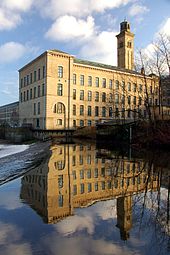 Saltaire, West Yorkshire, is a model mill town from the Industrial Revolution, and a World Heritage Site.
Saltaire, West Yorkshire, is a model mill town from the Industrial Revolution, and a World Heritage Site.
Under the newly formed Kingdom of Great Britain, output from the Royal Society and other English initiatives combined with the Scottish Enlightenment to create innovations in science and engineering. This paved the way for the establishment of the British Empire. Domestically it drove the Industrial Revolution, a period of profound change in the socioeconomic and cultural conditions of England, resulting in industrialised agriculture, manufacture, engineering and mining, as well as new and pioneering road, rail and water networks to facilitate their expansion and development.[69] The opening of Northwest England's Bridgewater Canal in 1761 ushered in the canal age in Britain.[70][71] In 1825 the world's first permanent steam locomotive-hauled passenger railway—the Stockton and Darlington Railway—opened to the public.[70]
During the Industrial Revolution, many workers moved from England's countryside to new and expanding urban industrial areas to work in factories, for instance at Manchester and Birmingham, dubbed "Warehouse City" and "Workshop of the World" respectively.[72][73] England maintained relative stability throughout the French Revolution; William Pitt the Younger was British Prime Minister for the reign of George III. During the Napoleonic Wars, Napoleon planned to invade from the south-east. However this failed to manifest and the Napoleonic forces were defeated by the British at sea by Lord Nelson and on land by the Duke of Wellington. The Napoleonic Wars fostered a concept of Britishness and a united national British people, shared with the Scots and Welsh.[74]
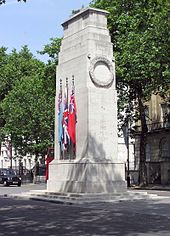 The Cenotaph, Whitehall is a memorial to members of the British Armed Forces who died during the two World Wars.
The Cenotaph, Whitehall is a memorial to members of the British Armed Forces who died during the two World Wars.
London became the largest and most populous metropolitan area in the world during the Victorian era, and trade within the British Empire—as well as the standing of the British military and navy—was prestigious.[75] Political agitation at home from radicals such as the Chartists and the suffragettes enabled legislative reform and universal suffrage.[76] Power shifts in east-central Europe led to World War I; hundreds of thousands of English soldiers died fighting for the United Kingdom as part of the Allies.[note 5] Two decades later, in World War II, the United Kingdom was again one of the Allies. At the end of the Phoney War, Winston Churchill became the wartime Prime Minister. Developments in warfare technology saw many cities damaged by air-raids during the Blitz. Following the war, the British Empire experienced rapid decolonisation, and there was a speeding up of technological innovations; automobiles became the primary means of transport and Frank Whittle's development of the jet engine led to wider air travel.[78] Residential patterns were altered in England by private motoring, and by the creation of the National Health Service (NHS) in 1948. England's NHS provided publicly funded health care to all UK permanent residents free at the point of need, being paid for from general taxation. Combined, these changes prompted the reform of local government in England in the mid-20th century.[79][80]
Since the 20th century there has been significant population movement to England, mostly from other parts of the British Isles, but also from the Commonwealth, particularly the Indian subcontinent.[81] Since the 1970s there has been a large move away from manufacturing and an increasing emphasis on the service industry.[82] As part of the United Kingdom, the area joined a common market initiative called the European Economic Community which became the European Union. Since the late 20th century the administration of the United Kingdom has moved towards devolved governance in Scotland, Wales and Northern Ireland.[83] England and Wales continues to exist as a jurisdiction within the United Kingdom.[84] Devolution has stimulated a greater emphasis on a more English-specific identity and patriotism.[85][86] There is no devolved English government, but an attempt to create a similar system on a sub-regional basis was rejected by referendum.[87]
Governance
Politics
As part of the United Kingdom, the basic political system in England is a constitutional monarchy and parliamentary system.[88] There has not been a Government of England since 1707, when the Acts of Union 1707, putting into effect the terms of the Treaty of Union, joined England and Scotland to form the Kingdom of Great Britain.[67] Before the union England was ruled by its monarch and the Parliament of England. Today England is governed directly by the Parliament of the United Kingdom, although other countries of the United Kingdom have devolved governments.[89] In the House of Commons which is the lower house of the British Parliament based at the Palace of Westminster, there are 532 Members of Parliament (MPs) for constituencies in England, out of the 650 total.[90]
In the United Kingdom general election, 2010 the Conservative Party had won an absolute majority in England's 532 contested seats with 61 seats more than all other parties combined (the Speaker of the House not being counted as a Conservative). However, taking Scotland, Northern Ireland and Wales into account this was not enough to secure an overall majority, resulting in a hung parliament.[91] In order to achieve a majority the Conservative party, headed by David Cameron, entered into a coalition agreement with the third largest party, the Liberal Democrats, led by Nick Clegg. Subsequently the Labour Party leader, Gordon Brown was forced to step down as prime minister[92] and leader of the Labour party, now led by Ed Miliband.
As the United Kingdom is a member of the European Union, there are elections held regionally in England to decide who is sent as Members of the European Parliament. The 2009 European Parliament election saw the regions of England elect the following MEPs: 23 Conservatives, ten Labour, nine UK Independence Party (UKIP), nine Liberal Democrats, two Greens and two British National Party (BNP).[93]
Since devolution, in which other countries of the United Kingdom—Scotland, Wales and Northern Ireland—each have their own devolved parliament or assemblies for local issues, there has been debate about how to counterbalance this in England. Originally it was planned that various regions of England would be devolved, but following the proposal's rejection by the North East in a referendum, this has not been carried out.[87]
One major issue is the West Lothian question, in which MPs from Scotland and Wales are able to vote on legislation affecting only England, while English MPs have no equivalent right to legislate on devolved matters.[94] This when placed in the context of England being the only country of the United Kingdom not to have free cancer treatment, prescriptions, residential care for the elderly and free top-up university fees,[95] has led to a steady rise in English nationalism.[96] Some have suggested the creation of a devolved English parliament,[97] while others have proposed simply limiting voting on legislation which only affects England to English MPs.[98]
Law
The English law legal system, developed over the centuries, is the basis of common law[99] legal systems used in most Commonwealth countries[100] and the United States (except Louisiana). Despite now being part of the United Kingdom, the legal system of the Courts of England and Wales continued, under the Treaty of Union, as a separate legal system from the one used in Scotland. The general essence of English law is that it is made by judges sitting in courts, applying their common sense and knowledge of legal precedent—stare decisis—to the facts before them.[101]
The court system is headed by the Supreme Court of Judicature, consisting of the Court of Appeal, the High Court of Justice for civil cases, and the Crown Court for criminal cases.[102] The Supreme Court of the United Kingdom is the highest court for criminal and civil cases in England and Wales. It was created in 2009 after constitutional changes, taking over the judicial functions of the House of Lords.[103] A decision of the Supreme Court is binding on every other court in the hierarchy, which must follow its directions.[104]
Crime increased between 1981 and 1995, but fell by 42% in the period 1995–2006.[105] The prison population doubled over the same period, giving it the highest incarceration rate in Western Europe at 147 per 100,000.[106] Her Majesty's Prison Service, reporting to the Ministry of Justice, manages most prisons, housing over 80,000 convicts.[106]
Regions, counties, and districts
The subdivisions of England consist of up to four levels of subnational division controlled through a variety of types of administrative entities created for the purposes of local government. The highest tier of local government were the nine regions of England: North East, North West, Yorkshire and the Humber, East Midlands, West Midlands, East, South East, South West, and London. These were created in 1994 as Government Offices, used by the British Government to deliver a wide range of policies and programmes regionally, but there are no elected bodies at this level, except in London, and in 2011 the regional Government offices were abolished.[107] The same boundaries remain in use for electing Members of the European Parliament on a regional basis.
After devolution began to take place in other parts of the United Kingdom it was planned that referendums for the regions of England would take place for their own elected regional assemblies as a counterweight. London accepted in 1998: the London Assembly was created two years later. However, when the proposal was rejected by the northern England devolution referendums, 2004 in the North East, further referendums were cancelled.[87] The regional assemblies outside London were abolished in 2010, and their functions transferred to respective Regional Development Agencies and a new system of local authority leaders' boards.[108]
Below the regional level, all of England is divided into 48 ceremonial counties.[109] These are used primarily as a geographical frame of reference and have developed gradually since the Middle Ages, with some established as recently as 1974.[110] Each has a Lord Lieutenant and High Sheriff; these posts are used to represent the British monarch locally.[109] Outside Greater London and the Isles of Scilly, England is also divided into 83 metropolitan and non-metropolitan counties; these correspond to areas used for the purposes of local government[111] and may consist of a single district or be divided into several.
There are six metropolitan counties based on the most heavily urbanised areas, which do not have county councils.[111] In these areas the principal authorities are the councils of the subdivisions, the metropolitan boroughs. Elsewhere, 27 non-metropolitan "shire" counties have a county council and are divided into districts, each with a district council. They are typically, though not always, found in more rural areas. The remaining non-metropolitan counties are of a single district and usually correspond to large towns or counties with low populations; they are known as unitary authorities. Greater London has a different system for local government, with 32 London boroughs, plus the City of London covering a small area at the core, governed by the City of London Corporation.[112] At the most localised level, much of England is divided into civil parishes with councils; they do not exist in Greater London.[113]
Geography
Landscape and rivers
Geographically England includes the central and southern two-thirds of the island of Great Britain, plus such offshore islands as the Isle of Wight and the Isles of Scilly. It is bordered by two other countries of the United Kingdom—to the north by Scotland and to the west by Wales. England is closer to the European continent than any other part of mainland Britain. It is separated from France by a 34-kilometre (21 mi)[114] sea gap, though the two countries are connected by the Channel Tunnel near Folkestone.[115] England also has shores on the Irish Sea, North Sea and Atlantic Ocean.
The ports of London, Liverpool, and Newcastle lie on the tidal rivers Thames, Mersey and Tyne respectively. At 354 kilometres (220 mi), the Severn is the longest river flowing through England.[116] It empties into the Bristol Channel and is notable for its Severn Bore tidal waves, which can reach 2 metres (6.6 ft) in height.[117] However, the longest river entirely in England is the Thames, which is 346 kilometres (215 mi) in length.[118] There are many lakes in England; the largest is Windermere, within the aptly named Lake District.[119]
In geological terms, the Pennines, known as the "backbone of England", are the oldest range of mountains in the country, originating from the end of the Paleozoic Era around 300 million years ago.[120] Their geological composition includes, among others, sandstone and limestone, and also coal. There are karst landscapes in calcite areas such as parts of Yorkshire and Derbyshire. The Pennine landscape is high moorland in upland areas, indented by fertile valleys of the region's rivers. They contain three national parks, the Yorkshire Dales, Northumberland, and the Peak District. The highest point in England, at 978 metres (3,209 ft), is Scafell Pike in Cumbria.[119] Straddling the border between England and Scotland are the Cheviot Hills.
The English Lowlands are to the south of the Pennines, consisting of green rolling hills, including the Cotswold Hills, Chiltern Hills, North and South Downs—where they meet the sea they form white rock exposures such as the cliffs of Dover. The granite Southwest Peninsula in the West Country includes upland moorland, such as Dartmoor and Exmoor, and enjoys a mild climate; both are national parks.[121]
Climate
Main article: Climate of EnglandEngland has a temperate maritime climate: it is mild with temperatures not much lower than 0 °C (32 °F) in winter and not much higher than 32 °C (90 °F) in summer.[122] The weather is damp relatively frequently and is changeable. The coldest months are January and February, the latter particularly on the English coast, while July is normally the warmest month. Months with mild to warm weather are May, June, September and October.[122] Rainfall is spread fairly evenly throughout the year.
Important influences on the climate of England are its proximity to the Atlantic Ocean, its northern latitude and the warming of the sea by the Gulf Stream.[122] Rainfall is higher in the west, and parts of the Lake District receive more rain than anywhere else in the country.[122] Since weather records began, the highest temperature recorded was 38.5 °C (101.3 °F) on 10 August 2003 at Brogdale in Kent,[123] while the lowest was −26.1 °C (−15.0 °F) on 10 January 1982 in Edgmond, Shropshire.[124]
Climate data for England Month Jan Feb Mar Apr May Jun Jul Aug Sep Oct Nov Dec Year Average high °C (°F) 7
(45)7
(45)9
(48)12
(54)15
(59)18
(64)21
(70)21
(70)18
(64)14
(57)10
(50)7
(45)13 Average low °C (°F) 1
(34)1
(34)2
(36)4
(39)6
(43)9
(48)11
(52)11
(52)9
(48)7
(45)4
(39)2
(36)6 Precipitation mm (inches) 84
(3.31)60
(2.36)67
(2.64)57
(2.24)56
(2.2)63
(2.48)54
(2.13)67
(2.64)73
(2.87)84
(3.31)84
(3.31)90
(3.54)838
(32.99)Source: Met Office[125] Major conurbations
The Greater London Urban Area is by far the largest metropolitan area in England[126] and one of the busiest cities in the world. It is considered a global city and has a population larger than other countries in the United Kingdom besides England itself.[126] Other urban areas of considerable size and influence tend to be in northern England or the English Midlands.[126] There are fifty settlements which have been designated city status in England, while the wider United Kingdom has sixty-six.
While many cities in England are quite large in size, such as Birmingham, Sheffield, Manchester, Liverpool, Leeds, Newcastle, Bradford, Nottingham and others, a large population is not necessarily a prerequisite for a settlement to be afforded city status.[127] Traditionally the status was afforded to towns with diocesan cathedrals and so there are smaller cities like Wells, Ely, Ripon, Truro and Chichester.[127] According to the Office for National Statistics the ten largest, continuous built-up urban areas are:[126]
Rank Urban area Population Localities Major localities 1 Greater London Urban Area 8,278,251 67 Greater London, divided into the City of London and 32 London boroughs including Croydon, Barnet, Ealing, Bromley[128] 2 West Midlands Urban Area 2,284,093 22 Birmingham, Wolverhampton, Dudley, Walsall 3 Greater Manchester Urban Area 2,240,230 57 Manchester, Salford, Bolton, Stockport, Oldham 4 West Yorkshire Urban Area 1,499,465 26 Leeds, Bradford, Huddersfield, Wakefield, Halifax 5 Tyneside 879,996 25 Newcastle, North Shields, South Shields, Gateshead, Jarrow 6 Liverpool Urban Area 816,216 8 Liverpool, St Helens, Bootle, Huyton-with-Roby 7 Nottingham Urban Area 666,358 15 Nottingham, Beeston and Stapleford, Carlton, Long Eaton 8 Sheffield Urban Area 640,720 7 Sheffield, Rotherham, Chapeltown, Mosborough 9 Bristol Urban Area 551,066 7 Bristol, Kingswood, Mangotsfield, Stoke Gifford 10 Brighton/Worthing/Littlehampton 461,181 10 Brighton, Worthing, Hove, Littlehampton, Shoreham, Lancing Economy
England's economy is one of the largest in the world, with an average GDP per capita of £22,907.[131] Usually regarded as a mixed market economy, it has adopted many free market principles, yet maintains an advanced social welfare infrastructure.[132] The official currency in England is the pound sterling, whose ISO 4217 code is GBP. Taxation in England is quite competitive when compared to much of the rest of Europe—as of 2009 the basic rate of personal tax is 20% on taxable income up to £37,400, and 40% on any additional earnings above that amount.[133]
The economy of England is the largest part of the UK's economy,[131] which has the 18th highest GDP PPP per capita in the world. England is a leader in the chemical[134] and pharmaceutical sectors and in key technical industries, particularly aerospace, the arms industry, and the manufacturing side of the software industry. London, home to the London Stock Exchange, the United Kingdom's main stock exchange and the largest in Europe, is England's financial centre—100 of Europe's 500 largest corporations are based in London.[135] London is the largest financial centre in Europe, and as of 2009[update] is also the largest in the world.[136]
The Bank of England, founded in 1694 by Scottish banker William Paterson, is the United Kingdom's central bank. Originally established as private banker to the Government of England, since 1946 it has been a state-owned institution.[137] The Bank has a monopoly on the issue of banknotes in England and Wales, although not in other parts of the United Kingdom. The government has devolved responsibility to the Bank's Monetary Policy Committee for managing the monetary policy of the country and setting interest rates.[138]
England is highly industrialised, but since the 1970s there has been a decline in traditional heavy and manufacturing industries, and an increasing emphasis on a more service industry oriented economy.[82] Tourism has become a significant industry, attracting millions of visitors to England each year. The export part of the economy is dominated by pharmaceuticals, cars—although many English marques are now foreign-owned, such as Rolls-Royce, Lotus, Jaguar and Bentley—crude oil and petroleum from the English parts of North Sea oil along with Wytch Farm, aircraft engines and alcoholic beverages.[139] Agriculture is intensive and highly mechanised, producing 60% of food needs with only 2% of the labour force.[140] Two thirds of production is devoted to livestock, the other to arable crops.[141]
Science and technology
Prominent English figures from the field of science and mathematics include Sir Isaac Newton, Michael Faraday, Robert Hooke, Robert Boyle, Joseph Priestley, J. J. Thomson, Charles Babbage, Charles Darwin, Stephen Hawking, Christopher Wren, Alan Turing, Francis Crick, Joseph Lister, Tim Berners-Lee, Paul Dirac, Andrew Wiles and Richard Dawkins. Some experts claim that the earliest concept of a metric system was invented by John Wilkins, the first secretary of the Royal Society, in 1668.[142] As the birthplace of the Industrial Revolution, England was home to many significant inventors during the late 18th and early 19th centuries. Famous English engineers include Isambard Kingdom Brunel, best known for the creation of the Great Western Railway, a series of famous steamships, and numerous important bridges, hence revolutionising public transport and modern-day engineering.[143] Thomas Newcomen's steam engine helped spawn the Industrial Revolution.[144] The physician Edward Jenner's smallpox vaccine is said to have "saved more lives [...] than were lost in all the wars of mankind since the beginning of recorded history."[145][146][147]
Inventions and discoveries of the English include: the jet engine, the first industrial spinning machine, the first computer and the first modern computer, the World Wide Web along with HTTP and HTML, the first successful human blood transfusion, the motorised vacuum cleaner,[148] the lawn mower, the seat belt, the hovercraft, the electric motor, steam engines, and theories such as the Darwinian theory of evolution and atomic theory. Newton developed the ideas of universal gravitation, Newtonian mechanics, and infinitesimal calculus, and Robert Hooke his eponymously named law of elasticity. Other inventions include the iron plate railway, the thermosiphon, tarmac, the rubber band, the mousetrap, "cat's eye" road safety device, joint development of the light bulb, steam locomotives, the modern seed drill and many modern techniques and technologies used in precision engineering.[149]
Transport
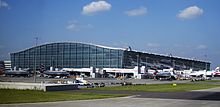 London Heathrow Airport has more international passenger traffic than any other airport in the world.[150]
London Heathrow Airport has more international passenger traffic than any other airport in the world.[150]
The Department for Transport is the government body responsible for overseeing transport in England. There are many motorways in England, and many other trunk roads, such as the A1 Great North Road, which runs through eastern England from London to Newcastle[151] (much of this section is motorway) and onward to the Scottish border. The longest motorway in England is the M6, from Rugby through the North West up to the Anglo-Scottish border.[151] Other major routes include: the M1 from London to Leeds, the M25 which encircles London, the M60 which encircles Manchester, the M4 from London to South Wales, the M62 from Liverpool via Manchester to East Yorkshire, and the M5 from Birmingham to Bristol and the South West.[151]
Bus transport across the country is widespread; major companies include National Express, Arriva and Go-Ahead Group. The red double-decker buses in London have become a symbol of England. There is a rapid rail network in two English cities: the London Underground; and the Tyne and Wear Metro in Newcastle, Gateshead and Sunderland.[152] There are several tram networks, such as the Blackpool tramway, Manchester Metrolink, Sheffield Supertram and Midland Metro, and the Tramlink system centred on Croydon in South London.[152]
Rail transport in England is the oldest in the world: passenger railways originated in England in 1825.[153] Much of Britain's 16,116 kilometres (10,014 mi) of rail network lies in England, covering the country fairly extensively, although a high proportion of railway lines were closed in the second half of the 20th century. These lines are mostly standard gauge (single, double or quadruple track) though there are also a few narrow gauge lines. There is rail transport access to France and Belgium through an undersea rail link, the Channel Tunnel, which was completed in 1994.
England has extensive domestic and international aviation links. The largest airport is London Heathrow, which is the world's busiest airport measured by number of international passengers.[154] Other large airports include Manchester Airport, London Stansted Airport, Luton Airport and Birmingham Airport.[150] By sea there is ferry transport, both local and international, including to Ireland, the Netherlands and Belgium.[155] There are around 7,100 km (4,400 mi) of navigable waterways in England, half of which is owned by British Waterways (Waterscape),[155] however water transport is very limited. The Thames is the major waterway in England, with imports and exports focused at the Port of Tilbury in the Thames Estuary, one of the United Kingdom's three major ports.[155]
Healthcare
The National Health Service (NHS) is the publicly funded healthcare system in England responsible for providing the majority of healthcare in the country. The NHS began on 5 July 1948, putting into effect the provisions of the National Health Service Act 1946. It was based on the findings of the Beveridge Report, prepared by economist and social reformer William Beveridge.[156] The NHS is largely funded from general taxation including National Insurance payments,[157] and it provides most of its services free at the point of use, although there are charges for some people for eye tests, dental care, prescriptions and aspects of personal care.[158]
The government department responsible for the NHS is the Department of Health, headed by the Secretary of State for Health, who sits in the British Cabinet. Most of the expenditure of the Department of Health is spent on the NHS—£98.6 billion was spent in 2008–2009.[159] In recent years the private sector has been increasingly used to provide more NHS services despite opposition by doctors and trade unions.[160] The average life expectancy of people in England is 77.5 years for males and 81.7 years for females, the highest of the four countries of the United Kingdom.[161]
Demography
Population
With over 51 million inhabitants, England is by far the most populous country of the United Kingdom, accounting for 84% of the combined total.[5] England taken as a unit and measured against international states has the fourth largest population in the European Union and would be the 25th largest country by population in the world.[162] With a density of 395 people per square kilometre, it would be the second most densely populated country in the European Union after Malta.[163][164]
The English people are a British people.[3] Some genetic evidence suggests that 75–95% descend in the paternal line from prehistoric settlers who originally came from the Iberian Peninsula, as well as a 5% contribution from Angles and Saxons, and a significant Norse element.[165][166][167] However, other geneticists place the Norse-Germanic estimate up to half.[168][169][170] Over time, various cultures have been influential: Prehistoric, Brythonic,[171] Roman, Anglo-Saxon,[172] Norse Viking,[173] Gaelic cultures, as well as a large influence from Normans. There is an English diaspora in former parts of the British Empire; especially the United States, Canada, Australia, Chile, South Africa and New Zealand.[note 6] Since the late 1990s, English people have migrated to Spain.[178][179]
At the time of the Domesday Book, compiled in 1086, more than 90% of the English population of about two million lived in the countryside.[181] By 1801 the population had grown to 8.3 million, and by 1901 had grown to 30.5 million.[182] Due in particular to the economic prosperity of South East England, there are many economic migrants from the other parts of the United Kingdom.[3] There has been significant Irish migration.[183] The proportion of ethnically European residents totals at 87.50%, including Germans[184] and Poles.[3]
Other people from much further afield in the former British colonies have arrived since the 1950s: in particular, 6.00% of people living in England have family origins in the Indian subcontinent, mostly India and Pakistan.[3][184] 2.90% of the population are black, mostly from the Caribbean.[3][184] There is a significant number of Chinese and British Chinese.[3][184] As of 2007[update], 22% of primary school children in England were from ethnic minority families.[185] About half of the population increase between 1991 and 2001 was due to immigration.[186] Debate over immigration is politically prominent;[187] according to a Home Office poll, 80% of people want to cap it.[188] The ONS has projected that the population will grow by six million between 2004 and 2029.[189]
Language
 The English-speaking world. Countries in dark blue have a majority of native speakers. Countries in light blue have English as an official language, de jure or de facto. English is also one of the official languages of the European Union.[190]
The English-speaking world. Countries in dark blue have a majority of native speakers. Countries in light blue have English as an official language, de jure or de facto. English is also one of the official languages of the European Union.[190]
As its name suggests, the English language, today spoken by hundreds of millions of people around the world, originated as the language of England, where it remains the principal tongue today. It is an Indo-European language in the Anglo-Frisian branch of the Germanic family.[191] After the Norman conquest, the Old English language was displaced and confined to the lower social classes as Norman French and Latin were used by the aristocracy.
By the 15th century, English came back into fashion among all classes, though much changed; the Middle English form showed many signs of French influence, both in vocabulary and spelling. During the English Renaissance, many words were coined from Latin and Greek origins.[192] Modern English has extended this custom of flexibility, when it comes to incorporating words from different languages. Thanks in large part to the British Empire, the English language is the world's unofficial lingua franca.[193]
English language learning and teaching is an important economic activity, and includes language schooling, tourism spending, and publishing. There is no legislation mandating an official language for England,[194] but English is the only language used for official business. Despite the country's relatively small size, there are many distinct regional accents, and individuals with particularly strong accents may not be easily understood everywhere in the country.
Cornish, which died out as a community language in the 18th century, is being revived,[195][196][197][198] and is now protected under the European Charter for Regional or Minority Languages.[199] It is spoken by 0.1% of people in Cornwall,[200] and is taught to some degree in several primary and secondary schools.[201][202] State schools teach students a second language, usually French, German or Spanish.[203] Due to immigration, it was reported in 2007 that around 800,000 school students spoke a foreign language at home,[185] the most common being Punjabi and Urdu.[204]
Religion
Christianity is the most widely practised religion in England, as it has been since the Early Middle Ages, although it was first introduced much earlier, in Gaelic and Roman times. It continued through Early Insular Christianity, and today about 72% of English people identify as Christians.[205] The largest form practised in the present day is Anglicanism,[206] dating from the 16th century Reformation period, with the 1536 split from Rome over Henry VIII wanting to divorce Catherine of Aragon; the religion regards itself as both Catholic and Reformed.
There are High Church and Low Church traditions, and some Anglicans regard themselves as Anglo-Catholics, after the Tractarian movement. The monarch of the United Kingdom is the head of the Church, acting as its Supreme Governor. It has the status of established church in England. There are around 26 million adherents to the Church of England and they form part of the Anglican Communion with the Archbishop of Canterbury acting as the symbolic worldwide head.[207] Many cathedrals and parish churches are historic buildings of significant architectural importance, such as Westminster Abbey, York Minster, Durham Cathedral and Salisbury Cathedral.
The second largest Christian practice is the Latin Rite of the Catholic Church, which traces its formal, corporate history in England to the 6th century with Augustine's mission and was the main religion on the entire island for around a thousand years. Since its reintroduction after the Catholic Emancipation, the Church has organised ecclesiastically on an England and Wales basis where there are 4.5 million members (most of whom are English).[208] There has been one Pope from England to date, Adrian IV; while saints Bede and Anselm are regarded as Doctors of the Church.
A form of Protestantism known as Methodism is the third largest and grew out of Anglicanism through John Wesley.[209] It gained popularity in the mill towns of Lancashire and Yorkshire, and amongst tin miners in Cornwall.[210] There are other non-conformist minorities, such as Baptists, Quakers, Congregationalists, Unitarians and The Salvation Army.[211]
The patron saint of England is Saint George; he is represented in the national flag, as well as the Union Flag as part of a combination.[212][212] There are many other English and associated saints; some of the best known include: Cuthbert, Alban, Wilfrid, Aidan, Edward the Confessor, John Fisher, Thomas More, Petroc, Piran, Margaret Clitherow and Thomas Becket. There are non-Christian religions practised. Jews have a history of a small minority on the island since 1070.[213] They were expelled from England in 1290 following the Edict of Expulsion, only to be allowed back in 1656.[213]
Especially since the 1950s, Eastern religions from the former British colonies have begun to appear, due to foreign immigration; Islam is the most common of these, accounting for around 3.1% in England.[205] Hinduism, Sikhism and Buddhism are next in number, adding up to 2% combined,[205] introduced from India and South East Asia.[205] Around 14.6% claim to have no religion.[205]
Education
The Department for Education is the government department responsible for issues affecting people in England up to the age of 19, including education.[214] State-run and -funded schools are attended by approximately 93% of English schoolchildren.[215] Of these, a minority are faith schools, primarily Church of England or Catholic. Between three and four is nursery school, 4 and 11 is primary school, and 11 to 16 is secondary school, with an option for a two-year extension to attend sixth form college.
Although most English secondary schools are comprehensive, in some areas there are selective intake grammar schools, to which entrance is subject to passing the eleven plus exam. Around 7.2% of English schoolchildren attend private schools, which are funded by private sources.[216] Standards in state schools are monitored by the Office for Standards in Education, and in private schools by the Independent Schools Inspectorate.[217]
After finishing compulsory education, pupils take a GCSE examination, following which they may decide to continue in further education and attend a further education college. Students normally enter universities in the United Kingdom from 18 onwards, where they study for an academic degree. There are over 90 universities England, all but one of which are public. The Department for Business, Innovation and Skills is the government department responsible for higher education in England.[218] Students are generally entitled to student loans for maintenance.[note 7] The first degree offered to undergraduates is the Bachelor's degree, which usually takes three years to complete. Students are then eligible for a postgraduate degree, a Master's degree, taking one year, or a Doctorate degree, which takes three.
England's universities include some of the highest-ranked universities in the world; the University of Cambridge, Imperial College London, the University of Oxford and University College London are all ranked in the global top 10 in the 2010 QS World University Rankings.[219] The London School of Economics has been described as the world's leading social science institution for both teaching and research.[220] The London Business School is considered one of the world's leading business schools and in 2010 its MBA programme was ranked best in the world by the Financial Times.[221] Academic degrees in England are usually split into classes: first class (I), upper second class (II:1), lower second class (II:2) and third (III), and unclassified (below third class).
The King's School, Canterbury and King's School, Rochester are the oldest schools in the English-speaking world.[222] Many of England's better-known schools, such as Winchester College, Eton College, St Paul's School, Rugby School, and Harrow School are fee-paying institutions.[223]
Culture
Architecture
Many ancient standing stone monuments were erected during the prehistoric period, amongst the best known are Stonehenge, Devil's Arrows, Rudston Monolith and Castlerigg.[224] With the introduction of Ancient Roman architecture there was a development of basilicas, baths, amphitheaters, triumphal arches, villas, Roman temples, Roman roads, Roman forts, stockades and aqueducts.[225] It was the Romans who founded the first cities and towns such as London, Bath, York, Chester and St Albans. Perhaps the best known example is Hadrian's Wall stretching right across northern England.[225] Another well preserved example is the Roman Baths at Bath, Somerset.[225]
Early Medieval architecture's secular buildings were simple constructions mainly using timber with thatch for roofing. Ecclesiastical architecture ranged from a synthesis of Hiberno—Saxon monasticism,[226][227] to Early Christian basilica and architecture characterised by pilaster-strips, blank arcading, baluster shafts and triangular headed openings. After the Norman conquest in 1066 various Castles in England were created so law lords could uphold their authority and in the north to protect from invasion. Some of the best known medieval castles include the Tower of London, Warwick Castle, Durham Castle and Windsor Castle amongst others.[228]
Throughout the Plantagenet era an English Gothic architecture flourished—the medieval cathedrals such as Canterbury Cathedral, Westminster Abbey and York Minster are prime examples.[228] Expanding on the Norman base there was also castles, palaces, great houses, universities and parish churches. Medieval architecture was completed with the 16th century Tudor style; the four-centred arch, now known as the Tudor arch, was a defining feature as were wattle and daub houses domestically. In the aftermath of the Renaissance a form of architecture echoing classical antiquity, synthesised with Christianity appeared—the English Baroque style, architect Christopher Wren was particularly championed.[229]
Georgian architecture followed in a more refined style, evoking a simple Palladian form; the Royal Crescent at Bath is one of the best examples of this. With the emergence of romanticism during Victorian period, a Gothic Revival was launched—in addition to this around the same time the Industrial Revolution paved the way for buildings such as The Crystal Palace. Since the 1930s various modernist forms have appeared whose reception is often controversial, though traditionalist resistance movements continue with support in influential places.[note 8]
Folklore
English folklore developed over many centuries. Some of the characters and stories are present across England, but most belong to specific regions. Common folkloric beings include pixies, giants, elfs, bogeymen, trolls, goblins and dwarves. While many legends and folk-customs are thought to be ancient, for instance the tales featuring Offa of Angel and Wayland the Smith,[231] others date from after the Norman invasion; Robin Hood and his Merry Men of Sherwood and their battles with the Sheriff of Nottingham being, perhaps, the best known.[232]
During the High Middle Ages tales originating from Brythonic traditions entered English folklore—the Arthurian myth.[233][234][235] These were derived from Anglo-Norman, French and Welsh sources,[234] featuring King Arthur, Camelot, Excalibur, Merlin and the Knights of the Round Table such as Lancelot. These stories are most centrally brought together within Geoffrey of Monmouth's Historia Regum Britanniae.[note 9] Another early figure from British tradition, King Cole, may have been based on a real figure from Sub-Roman Britain. Many of the tales and pseudo-histories make up part of the wider Matter of Britain, a collection of shared British folklore.
Some folk figures are based on semi or actual historical people whose story has been passed down centuries; Lady Godiva for instance was said to have ridden naked on horseback through Coventry, Hereward the Wake was a heroic English figure resisting the Norman invasion, Herne the Hunter is an equestrian ghost associated with Windsor Forest and Great Park and Mother Shipton is the archetypal witch.[237] On 5 November people make bonfires, set off fireworks and eat toffee apples in commemoration of the foiling of the Gunpowder Plot centred around Guy Fawkes. The chivalrous bandit, such as Dick Turpin, is a recurring character, while Blackbeard is the archetypal pirate. There are various national and regional folk activities, participated in to this day, such as Morris dancing, Maypole dancing, Rapper sword in the North East, Long Sword dance in Yorkshire, Mummers Plays, bottle-kicking in Leicestershire, and cheese-rolling at Cooper's Hill.[238] There is no official national costume, but a few are well established such as the Pearly Kings and Queens associated with cockneys, the Royal Guard, the Morris costume and Beefeaters.[239]
Cuisine
Since the Early Modern Period the food of England has historically been characterised by its simplicity of approach and a reliance on the high quality of natural produce.[240] During the Middle Ages and through the Renaissance period, English cuisine enjoyed an excellent reputation, though a decline began during the Industrial Revolution with the move away from the land and increasing urbanisation of the populace. The French sometimes referred to English people as les rosbifs, as a stereotype to suggest that English food is unsophisticated or crude.[241] The cuisine of England has, however, recently undergone a revival, which has been recognised by the food critics with some good ratings in Restaurant's best restaurant in the world charts.[242] An early book of English recipes is the Forme of Cury from the royal court of Richard II.[243]
Traditional examples of English food include the Sunday roast, featuring a roasted joint, usually beef, lamb or chicken, served with assorted boiled vegetables, Yorkshire pudding and gravy.[244] Other prominent meals include fish and chips and the full English breakfast—consisting of bacon, grilled tomatoes, fried bread, black pudding, baked beans, fried mushrooms, sausages and eggs. Various meat pies are consumed such as steak and kidney pie, cottage pie, Cornish pasty and pork pie, the last of which is eaten cold.[244]
Sausages are commonly eaten, either as bangers and mash or toad in the hole. Lancashire hotpot is a well known stew. Some of the most popular cheeses are Cheddar and Wensleydale. Many Anglo-Indian hybrid dishes, curries, have been created such as chicken tikka masala and balti. Sweet English dishes include apple pie, mince pies, spotted dick, scones, Eccles cakes, custard and sticky toffee pudding. Common drinks include tea, whose popularity was increased by Catherine of Braganza,[245] while alcoholic drinks include wines, ciders and English beers such as bitter, mild, stout, and brown ale.[246]
Visual arts
The earliest known examples are the prehistoric rock and cave art pieces, most prominent in North Yorkshire, Northumberland and Cumbria, but also feature further south, for example at Creswell Crags.[247] With the arrival of Roman culture in the 1st century, various forms of art utilising statues, busts, glasswork and mosaics were the norm. There are numerous surviving artefacts, such as those at Lullingstone and Aldborough.[248] During the Early Middle Ages the style was sculpted crosses and ivories, manuscript painting, gold and enamel jewellery, demonstrating a love of intricate, interwoven designs such as in the Staffordshire Hoard discovered in 2009. Some of these blended Gaelic and Anglian styles, such as the Lindisfarne Gospels and Vespasian Psalter.[249] Later Gothic art was popular at Winchester and Canterbury, examples survive such as Benedictional of St. Æthelwold and Luttrell Psalter.[250]
The Tudor era saw prominent artists as part of their court, portrait painting which would remain an enduring part of English art, was boosted by German Hans Holbein, natives such as Nicholas Hilliard built on this.[250] Under the Stuarts, Continental artists were influential especially the Flemish, examples from the period include—Anthony van Dyck, Peter Lely, Godfrey Kneller and William Dobson.[250] The 18th century was a time of significance with the founding of the Royal Academy, a classicism based on the High Renaissance prevailed—Thomas Gainsborough and Joshua Reynolds became two of England's most treasured artists.[250]
The Norwich School continued the landscape tradition, while the Pre-Raphaelite Brotherhood with their vivid and detailed style revived the Early Renaissance style—Holman Hunt, Dante Gabriel Rossetti and John Everett Millais were leaders.[250] Prominent amongst 20th century artists was Henry Moore, regarded as the voice of British sculpture, and of British modernism in general.[251] Contemporary painters include Lucian Freud, whose work Benefits Supervisor Sleeping in 2008 set a world record for sale value of a painting by a living artist.[252]
Literature, poetry and philosophy
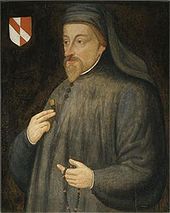 Geoffrey Chaucer was an English author, poet and philosopher, best remembered for his unfinished frame narrative The Canterbury Tales.
Geoffrey Chaucer was an English author, poet and philosopher, best remembered for his unfinished frame narrative The Canterbury Tales.
Early authors such as Bede and Alcuin wrote in Latin.[253] The period of Old English literature provided the epic poem Beowulf and the secular prose of the Anglo-Saxon Chronicle,[254] along with Christian writings such as Judith, Cædmon's Hymn and hagiographies.[253] Following the Norman conquest Latin continued amongst the educated classes, as well as an Anglo-Norman literature.
Middle English literature emerged with Geoffrey Chaucer, author of The Canterbury Tales, along with Gower, the Pearl Poet and Langland. William of Ockham and Roger Bacon, who were Franciscans, were major philosophers of the Middle Ages. Julian of Norwich, who wrote Revelations of Divine Love, was a prominent Christian mystic. With the English Renaissance literature in the Early Modern English style appeared. William Shakespeare, whose works include Hamlet, Romeo and Juliet, Macbeth, and A Midsummer Night's Dream, remains one of the most championed authors in English literature.[255]
Christopher Marlowe, Edmund Spenser, Philip Sydney, Thomas Kyd, John Donne, and Ben Jonson are other established authors of the Elizabethan age.[256] Francis Bacon and Thomas Hobbes wrote on empiricism and materialism, including scientific method and social contract.[256] Filmer wrote on the Divine Right of Kings. Marvell was the best known poet of the Commonwealth,[257] while John Milton authored Paradise Lost during the Restoration.
This royal throne of kings, this sceptred isle, this earth of majesty, this seat of Mars, this other Eden, demi-paradise; this fortress, built by nature for herself. This blessed plot, this earth, this realm, this England.
Some of the most prominent philosophers of the Enlightenment were John Locke, Thomas Paine, Samuel Johnson and Jeremy Bentham. More radical elements were later countered by Edmund Burke who is regarded as the founder of conservatism.[259] The poet Alexander Pope with his satirical verse became well regarded. The English played a significant role in romanticism: Samuel Taylor Coleridge, Lord Byron, John Keats, Mary Shelley, Percy Bysshe Shelley, William Blake and William Wordsworth were major figures.[260]
In response to the Industrial Revolution, agrarian writers sought a way between liberty and tradition; William Cobbett, G. K. Chesterton and Hilaire Belloc were main exponents, while the founder of guild socialism, Arthur Penty, and cooperative movement advocate G. D. H. Cole are somewhat related.[261] Empiricism continued through John Stuart Mill and Bertrand Russell, while Bernard Williams was involved in analytics. Authors from around the Victorian era include Charles Dickens, the Brontë sisters, Jane Austen, George Eliot, Rudyard Kipling, Thomas Hardy, H. G. Wells, Lewis Carroll and Evelyn Underhill.[262] Since then England has continued to produce novelists such as C. S. Lewis, George Orwell, D. H. Lawrence, Virginia Woolf, Enid Blyton, Aldous Huxley, Agatha Christie, Terry Pratchett, J. R. R. Tolkien, and J. K. Rowling.[263]
Performing arts
The traditional folk music of England is centuries old and has contributed to several genres prominently; mostly sea shanties, jigs, hornpipes and dance music. It has its own distinct variations and regional peculiarities. Wynkyn de Worde printed ballads of Robin Hood from the 16th century are an important artefact, as are John Playford's The Dancing Master and Robert Harley's Roxburghe Ballads collections.[264] Some of the best known songs are The Good Old Way, Pastime with Good Company, Maggie May and Spanish Ladies amongst others. Many nursery rhymes are of English origin such as Twinkle Twinkle Little Star, Roses are red, Jack and Jill, Here We Go Round the Mulberry Bush and Humpty Dumpty.[265]
Early English composers in classical music include Renaissance artists Thomas Tallis and William Byrd, followed up by Henry Purcell from the Baroque period. German-born George Frideric Handel became a British subject[266] and spent most of his composing life in London, creating some of the most well-known works of classical music, The Messiah, Water Music, and Music for the Royal Fireworks. There was a revival in the profile of composers from England in the 20th century led by Benjamin Britten, Frederick Delius, Edward Elgar, Gustav Holst, Ralph Vaughan Williams and others.[267] Present-day composers from England include Michael Nyman, best known for The Piano.
In the field of popular music many English bands and solo artists have been cited as the most influential and best-selling musicians of all time. Acts such as The Beatles, Led Zeppelin, Pink Floyd, Elton John, Queen, Rod Stewart and The Rolling Stones are among the highest selling recording artists in the world.[268] Many musical genres have origins or strong associations with England, such as British invasion, hard rock, glam rock, heavy metal, mod, britpop, drum and bass, progressive rock, punk rock, indie rock, gothic rock, shoegazing, acid house, UK garage, trip hop and dubstep.[269]
Large outdoor music festivals in the summer and autumn are popular, such as Glastonbury, V Festival, Reading and Leeds Festivals. The most prominent opera house in England is the Royal Opera House at Covent Garden.[270] The Proms, a season of orchestral classical music concerts held at the Royal Albert Hall, is a major cultural event held annually.[270] The Royal Ballet is one of the world's foremost classical ballet companies, its reputation built on two prominent figures of 20th century dance, prima ballerina Margot Fonteyn and choreographer Frederick Ashton.
Museums, libraries, and galleries
Further information: Museums in EnglandEnglish Heritage is a governmental body with a broad remit of managing the historic sites, artefacts and environments of England. It is currently sponsored by the Department for Culture, Media and Sport. The charity National Trust for Places of Historic Interest or Natural Beauty holds a contrasting role. 17 of the 25 United Kingdom UNESCO World Heritage Sites fall within England.[271] Some of the best known of these include; Hadrian's Wall, Stonehenge, Avebury and Associated Sites, Tower of London, Jurassic Coast, Saltaire, Ironbridge Gorge, Studley Royal Park and various others.[272]
There are many museums in England, but the most notable is London's British Museum. Its collection of more than seven million objects[273] is one of the largest and most comprehensive in the world,[274] sourced from every continent, illustrating and documenting the story of human culture from its beginning to the present. The British Library in London is the national library and is one of the world's largest research libraries, holding over 150 million items in all known languages and formats; including around 25 million books.[275] The most senior art gallery is the National Gallery in Trafalgar Square, which houses a collection of over 2,300 paintings dating from the mid-13th century to 1900.[276] The Tate galleries house the national collections of British and international modern art; they also host the famously controversial Turner Prize.[277]
Sports
England has a strong sporting heritage, and during the 19th century codified many sports that are now played around the world. Sports originating in England include association football,[279] cricket, rugby union, rugby league, tennis, badminton, squash,[280] rounders,[281] hockey, boxing, snooker, billiards, darts, table tennis, bowls, netball, thoroughbred horseracing and fox hunting. It has helped the development of sailing and Formula One. Football is the most popular of these sports. The England national football team, whose home venue is Wembley Stadium, won the 1966 FIFA World Cup, the year the country hosted the competition.
At club level England is recognised by FIFA as the birth-place of club football, due to Sheffield FC founded in 1857 being the oldest club.[279] The Football Association is the oldest of its kind, FA Cup and The Football League were the first cup and league competitions respectively. In the modern day the Premier League is the world's most lucrative football league[282] and amongst the elite.[283] The European Cup has been won by Liverpool, Manchester United, Nottingham Forest and Aston Villa, while Arsenal, Chelsea and Leeds United have reached the final.[284]
Cricket is generally thought to have been developed in the early medieval period among the farming and metalworking communities of the Weald.[285] The England cricket team is a composite England and Wales team. One of the game's top rivalries is The Ashes series between England and Australia, contested since 1882. The finale of the 2009 Ashes was watched by nearly 2 million people, although the climax of the 2005 Ashes was viewed by 7.4 million as it was available on terrestrial television.[286] England are the current holders of the trophy and are ranked 1st in Test and 4th in One Day International cricket.[287]
England has hosted four Cricket World Cups (1975, 1979, 1983, 1999) and the ICC World Twenty20 in 2009. There are several domestic level competitions, including the County Championship in which Yorkshire are by far the most successful club having won the competition 31 times.[288] Lord's Cricket Ground situated in London is sometimes referred to as the "Mecca of Cricket".[289] William Penny Brookes was prominent in organising the format for the modern Olympic Games. London hosted the Summer Olympic Games in 1908 and 1948, and will host them again in 2012. England competes in the Commonwealth Games, held every four years. Sport England is the governing body responsible for distributing funds and providing strategic guidance for sporting activity in England. A Grand Prix is held at Silverstone.[290]
The England rugby union team won the 2003 Rugby World Cup, the country was one of the host nations of the competition in the 1991 Rugby World Cup and is set to host the 2015 Rugby World Cup.[291] The top level of club participation is the English Premiership. Leicester Tigers, London Wasps, Bath Rugby and Northampton Saints have had success in the Europe-wide Heineken Cup. In another form of the sport—rugby league which was born in Huddersfield in 1895, the England national rugby league team are ranked third in the world and first in Europe.
Since 2008 England has been a full test nation in lieu of the Great Britain national rugby league team, which won three World Cups but is now retired. Club sides play in Super League, the present-day embodiment of the Rugby Football League Championship. Some of the most successful clubs include Wigan Warriors, St Helens, Leeds Rhinos and Huddersfield Giants; the former three have all won the World Club Challenge previously. The United Kingdom is to host the 2013 Rugby League World Cup.[292] In tennis, the Wimbledon Championships are the oldest tennis tournament in the world and is widely considered the most prestigious.[293][294]
National symbols
The St George's Cross has been the national flag of England since the 13th century. Originally the flag was used by the maritime Republic of Genoa. The English monarch paid a tribute to the Doge of Genoa from 1190 onwards, so that English ships could fly the flag as a means of protection when entering the Mediterranean. A red cross was a symbol for many Crusaders in the 12th and 13th centuries. It became associated with Saint George, along with countries and cities, which claimed him as their patron saint and used his cross as a banner.[295] Since 1606 the St George's Cross has formed part of the design of the Union Flag, a Pan-British flag designed by King James I.[212]
There are numerous other symbols and symbolic artefacts, both official and unofficial, including the Tudor rose, the nation's floral emblem, the White Dragon, and the Three Lions featured on the Royal Arms of England. The Tudor rose was adopted as a national emblem of England around the time of the Wars of the Roses as a symbol of peace.[296] It is a syncretic symbol in that it merged the white rose of the Yorkists and the red rose of the Lancastrians—cadet branches of the Plantagenets who went to war over control of the nation. It is also known as the Rose of England.[297] The oak tree is a symbol of England, representing strength and endurance. The term Royal Oak alludes to the escape of King Charles II from the grasp of the parliamentarians after his father's execution: he hid in an oak tree to avoid detection before safely reaching exile.
The Royal Arms of England, a national coat of arms featuring three lions, originated with its adoption by Richard the Lionheart in 1198. It is blazoned as gules, three lions passant guardant or and it provides one of the most prominent symbols of England; it is similar to the traditional arms of Normandy. England does not have an official designated national anthem, as the United Kingdom as a whole has God Save the Queen. However, the following are often considered unofficial English national anthems: Jerusalem, Land of Hope and Glory (used for England during the 2002 Commonwealth Games),[298] and I Vow to Thee, My Country. England's National Day is 23 April which is St George's Day: St George is the patron saint of England.[299]
See also
Notes
- ^ English is established by de facto usage.
- ^ Assigned on a United Kingdom basis, not constituent country.
- ^ According to the European Statistical Agency, London is the largest Larger Urban Zone which uses conurbations and areas of high population as its definition. A ranking of population within municipal boundaries places London first. However, the University of Avignon in France claims that Paris is first and London second when including the whole urban area and hinterland, that is the outlying cities as well.
- ^ As Roger Scruton explains, "The Reformation must not be confused with the changes introduced into the Church of England during the 'Reformation Parliament' of 1529–36, which were of a political rather than a religious nature, designed to unite the secular and religious sources of authority within a single sovereign power: the Anglican Church did not until later make substantial change in doctrine".[59]
- ^ Figure of 550,000 military deaths is for England and Wales[77]
- ^ For instance, in 1980 around 50 million Americans claimed English ancestry.[174] In Canada there are around 6.5 million Canadians who claim English ancestry.[175] Around 70% of Australians in 1999 denoted their origins as Anglo-Celtic, a category which includes all peoples from Great Britain and Ireland.[176] Chileans of English descent are somewhat of an anomaly in that Chile itself was never part of the British Empire, but today there are around 420,000 people of English origins living there.[177]
- ^ Students attending English universities now have to pay tuition fees towards the cost of their education, as do English students who choose to attend university in Scotland. Scottish students attending Scottish universities have their fees paid by the devolved Scottish Parliament.[95]
- ^ While people such as Norman Foster and Richard Rogers represent the modernist movement, Prince Charles since the 1980s has voiced strong views against it in favour of traditional architecture and put his ideas into practice at his Poundbury development in Dorset.[230] Architects like Raymond Erith, Francis Johnson and Quinlan Terry continued to practice in the classical style.
- ^ These tales may have come to prominence, at least in part, as an attempt by the Norman ruling elite to legitimise their rule of the British Isles, finding Anglo-Saxon history ill-suited to the task during an era when members of the deposed House of Wessex, especially Edgar the Ætheling and his nephews of the Scottish House of Dunkeld, were still active in the isles.[234][236] Also Michael Wood explains; "Over the centuries the figure of Arthur became a symbol of British history—a way of explaining the matter of Britain, the relationship between the Saxons and the Celts, and a way of exorcising ghosts and healing the wounds of the past."[233]
References
- ^ Marden 2003, p. 460.
- ^ Brewer 2006, p. 340.
- ^ a b c d e f g Office for National Statistics (2001). "Ethnic group: Census 2001, Key Statistics for local Authorities". United Kingdom Census 2001. Statistics.gov.uk. http://www.statistics.gov.uk/statbase/ssdataset.asp?vlnk=6561. Retrieved 2009-09-05.[dead link]
- ^ Office for National Statistics (2009). "Population Estimates by Ethnic Group (experimental)". neighbourhood.statistics.gov.uk. http://www.neighbourhood.statistics.gov.uk/dissemination/LeadTableView.do?a=3&b=276743&c=london&d=13&e=13&g=325264&i=1001x1003x1004&o=322&m=0&r=1&s=1305747150781&enc=1&dsFamilyId=1812. Retrieved 2011-05-18.
- ^ a b Office for National Statistics. "Population estimates for UK, England and Wales, Scotland and Northern Ireland – current datasets". statistics.gov.uk. http://www.statistics.gov.uk/statbase/Product.asp?vlnk=15106. Retrieved 2009-06-05.[dead link]
- ^ Office for National Statistics. "The Countries of the UK". statistics.gov.uk. http://www.statistics.gov.uk/geography/uk_countries.asp. Retrieved 2009-02-01.[dead link]
- ^ "Countries within a country". number-10.gov.uk. Archived from the original on 2008-02-09. http://web.archive.org/web/20080209003312/http://www.number-10.gov.uk/output/Page823.asp. Retrieved 2009-02-01.
- ^ "Changes in the list of subdivision names and code elements (Page 11)" (PDF). International Organization for Standardization. http://www.iso.org/iso/newsletter_i-9.pdf. Retrieved 2009-02-01.
- ^ "England – Culture". britainusa.com. Archived from the original on 2008-05-16. http://web.archive.org/web/20080516162153/http://www.britainusa.com/sections/index_nt1.asp?i=41105&L1=41105&L2=41105&D=0. Retrieved 2009-02-01.
- ^ "Country profile: United Kingdom". BBC News (news.bbc.co.uk). 2009-10-26. http://news.bbc.co.uk/1/hi/world/europe/country_profiles/1038758.stm. Retrieved 2009-02-01.
- ^ "Industrial Revolution". Ace.mmu.ac.uk. http://www.ace.mmu.ac.uk/eae/Global_Warming/Older/Industrial_Revolution.html. Retrieved 2009-02-01.
- ^ The Royal Society. "History of the Royal Society". royalsociety.org. http://royalsociety.org/page.asp?id=1058. Retrieved 2009-02-01.
- ^ William E. Burns, A Brief History of Great Britain, p. xxi
- ^ Acts of Union 1707 parliament.uk, accessed 27 January 2011
- ^ "England". Online Etymology Dictionary. http://www.etymonline.com/index.php?term=England. Retrieved 21 July 2010.
- ^ Ripley 1869, p. 570.
- ^ "England". Oxford English Dictionary. http://dictionary.oed.com/cgi/entry/50075354?single=1&query_type=word&queryword=England&first=1&max_to_show=10. Retrieved 2009-09-05.
- ^ "Germania". Tacitus. http://www.fordham.edu/halsall/basis/tacitus-germanygord.html. Retrieved 2009-09-05.
- ^ "Angle". Oxford English Dictionary. http://dictionary.oed.com/cgi/entry/50075354?single=1&query_type=word&queryword=Angle&first=1&max_to_show=10. Retrieved 2009-09-05.
- ^ Crystal 2004, pp. 26–27
- ^ a b Massey 2007, p. 440.
- ^ Room 2006, p. 23.
- ^ Major 2004, p. 84.
- ^ Foster 1988, p. 9.
- ^ "500,000 BC – Boxgrove". Current Archaeology. Current Publishing. http://www.archaeology.co.uk/the-timeline-of-britain/boxgrove.htm. Retrieved 2010-12-20.
- ^ "Palaeolithic Archaeology Teaching Resource Box". Palaeolithic Rivers of South-West Britain Project(2006). http://www.personal.rdg.ac.uk/~sgs04rh/SWRivers/Palaeolithic%20Archaeology%20Teaching%20Resource%20Box_Lifestyles_Basic.pdf. Retrieved 20 December 2010.
- ^ "Chalk east". A Geo East Project. http://www.geo-east.org.uk/special_projects/eco_culture.htm. Retrieved 20 December 2010.
- ^ Oppenheimer 2006, p. 173.
- ^ "Tertiary Rivers: Tectonic and structural background". University of Cambridge. http://www.qpg.geog.cam.ac.uk/research/projects/tertiaryrivers/tectonics.html. Retrieved 2009-09-09.
- ^ "Function and significance of Bell Beaker pottery according to data from residue analyses". http://tp.revistas.csic.es/index.php/tp/article/viewFile/5/5. Retrieved 21 December 2010.
- ^ Koch, John (2009). Tartessian: Celtic from the Southwest at the Dawn of History in Acta Palaeohispanica X Palaeohispanica 9 (2009). Palaeohispanica. pp. 339–351. ISSN 1578-5386. http://ifc.dpz.es/recursos/publicaciones/29/54/26koch.pdf. Retrieved 2010-05-17.
- ^ Cunliffe, Karl, Guerra, McEvoy, Bradley; Oppenheimer, Rrvik, Isaac, Parsons, Koch, Freeman and Wodtko (2010). Celtic from the West: Alternative Perspectives from Archaeology, Genetics, Language and Literature. Oxbow Books and Celtic Studies Publications. p. 384. ISBN 978-1-84217-410-4. http://www.oxbowbooks.com/bookinfo.cfm/ID/88298//Location/DBBC.
- ^ Cunliffe, Barry (2008). A Race Apart: Insularity and Connectivity in Proceedings of the Prehistoric Society 75, 2009. The Prehistoric Society. p. 61.
- ^ Reid, Struan (1994). Inventions and Trade. P.8. ISBN 9780921921301. http://books.google.com/?id=bn88JPk_Fr0C&printsec=frontcover&dq=inventions+in+trade#v=onepage&q&f=false. Retrieved 23 December 2010.
- ^ Burke, Jason (2 December 2000). "Dig uncovers Boudicca's brutal streak". The Observer (London). http://observer.guardian.co.uk/uk_news/story/0,6903,406152,00.html. Retrieved 2009-09-05.
- ^ "Cornelius Tacitus, The Annals". Alfred John Church, William Jackson Brudribh, Ed. http://www.perseus.tufts.edu/hopper/text?doc=Tac.+Ann.+14.37&redirect=true. Retrieved 22 December 2010.
- ^ Bedoyere, Guy. "Architecture in Roman Britain". Heritage Key. http://heritage-key.com/publication/architecture-roman-britain. Retrieved 23 December 2010.
- ^ Philip, Robert (1860). Thr History of Progress in Great Britain, Volume 2. http://books.google.com/?id=bylBAAAAIAAJ&pg=PA276&dq=roman+law+after+roman+invasion+of+britain#v=onepage&q=roman%20law%20after%20roman%20invasion%20of%20britain&f=false. Retrieved 23 December 2010.
- ^ Bob Rees, Paul Shute, Nigel Kelly (2003-01-09). Medicine through time. Heinemann. ISBN 9780435308414. http://books.google.com/?id=1qiFEQ1tAHQC&pg=PT119&dq=roman+occupation+brought+to+britain+a+sewage+system#v=onepage&q&f=false. Retrieved 24 December 2010.
- ^ Rankov 1994, p. 16.
- ^ Wright 2008, p. 143.
- ^ a b James, Edward. "Overview: Anglo-Saxons, 410 to 800". BBC. http://www.bbc.co.uk/history/ancient/anglo_saxons/overview_anglo_saxons_01.shtml. Retrieved 2010-12-03.
- ^ "The Christian Tradition". PicturesofEngland.com. http://www.picturesofengland.com/history/england-history-p4.html. Retrieved 2009-09-05.
- ^ Kirby 2000, p. 4
- ^ Lyon 1960, p. 23.
- ^ "Overview: The Normans, 1066–1154". BBC. http://www.bbc.co.uk/history/british/normans/overview_normans_01.shtml. Retrieved 2010-12-03.
- ^ Crouch 2006, pp. 2–4
- ^ "Norman invasion word impact study". BBC News. 20 February 2008. http://news.bbc.co.uk/1/hi/wales/mid/7254446.stm. Retrieved 2010-12-03.
- ^ a b Bartlett 1999, p. 124.
- ^ "Edward I (r. 1272–1307)". Royal.gov.uk. Archived from the original on 2008-06-24. http://web.archive.org/web/20080624181028/http://www.royal.gov.uk/OutPut/Page61.asp. Retrieved 2009-09-21.
- ^ Fowler 1967, p. 208.
- ^ Ziegler 2003, p. 230.
- ^ Goldberg 1996, p. 4.
- ^ Crofton 2007, p. 111.
- ^ "Richard III (r. 1483–1485)". Royal.gov.uk. Archived from the original on 2008-07-10. http://web.archive.org/web/20080710093939/http://www.royal.gov.uk/output/Page50.asp. Retrieved 2009-09-21.
- ^ Denys Hay (1988). Renaissance essays. p. 65. ISBN 9780907628965. http://books.google.com/?id=jzm2Vu9h-CYC&pg=PA165&dq=italian+influence+on+the+english+renaissance#v=onepage&q=italian%20influence%20on%20the%20english%20renaissance&f=false. Retrieved 26 December 2010.
- ^ "Royal Navy History, Tudor Period and the Birth of a Regular Navy". http://www.royal-navy.org/lib/index.php?title=Tudor_Period_and_the_Birth_of_a_Regular_Navy_Part_Two. Retrieved 24 December 2010.
- ^ Goldwin Smith. England Under the Tudors. p. 176. ISBN 9781606209394. http://books.google.com/?id=RdOTQUDgH54C&printsec=frontcover&dq=england+under+the+tudors+by+goldwin+smith#v=onepage&q&f=false. Retrieved 26 December 2010.
- ^ Scruton 1982, p. 470.
- ^ Karen Ordahl (2007-02-25). Roanak:the abandoned colony. Rowman & Littlefield publishers Inc. ISBN 9780742552630. http://books.google.com/?id=W8cr4Vgt9ekC&printsec=frontcover&dq=roanoke+colony#v=onepage&q&f=false. Retrieved 24 December 2010.
- ^ a b Colley 1992, p. 12.
- ^ "Making the Act of Union". Parliament.uk. Archived from the original on June 9, 2008. http://web.archive.org/web/20080609075346/http://www.parliament.uk/actofunion/01_background.html. Retrieved 2009-09-05.
- ^ Hay, Denys. "The term "Great Britain" in the Middle Ages" (PDF). ads.ahds.ac.uk. http://ads.ahds.ac.uk/catalogue/adsdata/PSAS_2002/pdf/vol_089/89_055_066.pdf. Retrieved 2009-02-19.[dead link]
- ^ "Oliver Cromwell (English statesman)". Encyclopædia Britannica. britannica.com. 2009. http://www.britannica.com/EBchecked/topic/143822/Oliver-Cromwell. Retrieved 2009-08-08.
- ^ Philip J. Adler, Randall L. Pouwels (2007-11-27). World Civilization. p. 340. ISBN 9780495502623. http://books.google.com/?id=mPoqfoiIp4sC&pg=PA340&lpg=PA340&dq=with+the+restoration+it+was+not+constitutionally+established+that+king+and+parliament+should+rule+together#v=onepage&q&f=false. Retrieved 24 December 2010.
- ^ "London's Burning: The Great Fire". BBC News. http://www.bbc.co.uk/history/british/civil_war_revolution/great_fire_02.shtml. Retrieved 2009-09-25.
- ^ a b "The first Parliament of Great Britain". Parliament.uk. Archived from the original on June 21, 2008. http://web.archive.org/web/20080621165514/http://www.parliament.uk/actofunion/08_02_great.html. Retrieved 2009-09-05.
- ^ Gallagher 2006, p. 14.
- ^ Hudson, Pat. "The Workshop of the World". BBC. http://www.bbc.co.uk/history/british/victorians/workshop_of_the_world_01.shtml. Retrieved 2010-12-10.
- ^ a b Office for National Statistics 2000, p. 5
- ^ McNeil & Nevell 2000, p. 4.
- ^ McNeil & Nevell 2000, p. 9.
- ^ Birmingham City Council. "Heritage". visitbirmingham.com. http://www.visitbirmingham.com/arts_and_culture/heritage/. Retrieved 2009-10-04.
- ^ Colley 1992, p. 1.
- ^ Robert F. Haggard (2001). The persistence of Victorian liberalism:The Politics of Social Reform in Britain, 1870–1900. p. 13. ISBN 9780313313059. http://books.google.com/?id=53VUwDw_UYMC&pg=PA13&dq=prestige+of+the+british+empire+in+victorian+times#v=onepage&q=prestige%20of%20the%20british%20empire%20in%20victorian%20times&f=false. Retrieved 26 December 2010.
- ^ Crawford, Elizabeth. "Women: From Abolition to the Vote". BBC. http://www.bbc.co.uk/history/british/abolition/abolition_women_article_01.shtml#five. Retrieved 2010-12-10.
- ^ Cox 1970, p. 180
- ^ Golley, John (10 August 1996). "Obituaries: Air Commodore Sir Frank Whittle". The Independent (London). http://www.independent.co.uk/news/people/obituaries-air-commodore-sir-frank-whittle-1309015.html. Retrieved 2010-12-02.
- ^ Clark 1973, p. 1.
- ^ Wilson & Game 2002, p. 55.
- ^ Gallagher 2006, pp. 10–11.
- ^ a b Reitan 2003, p. 50.
- ^ Keating, Michael (1 January 1998). "Reforging the Union: Devolution and Constitutional Change in the United Kingdom". Publius: the Journal of Federalism 28 (1): 217. http://publius.oxfordjournals.org/cgi/content/abstract/28/1/217. Retrieved 2009-02-04
- ^ "The coming of the Tudors and the Act of Union". BBC Wales. BBC News. 2009. http://www.bbc.co.uk/wales/history/sites/themes/guide/ch11_part2_coming_of_the_tudor.shtml. Retrieved 2009-09-09.
- ^ Kenny, English & Hayton 2008, p. 3.
- ^ Ward 2004, p. 180.
- ^ a b c Sherman, Jill; Norfolk, Andrew (5 November 2004). "Prescott's dream in tatters as North East rejects assembly". The Times (London). http://www.timesonline.co.uk/tol/news/uk/article503255.ece. Retrieved 2009-09-05.
- ^ "The British Parliamentary System". BBC News. http://www.bbc.co.uk/dna/h2g2/A591383. Retrieved 2010-04-20.
- ^ Cabinet Office (2009-03-26). "Devolution in the United Kingdom". cabinetoffice.gov.uk. http://www.cabinetoffice.gov.uk/devolution.aspx. Retrieved 2009-08-16.
- ^ "Lists of MPs". Parliament.uk. http://www.parliament.uk/mps-lords-and-offices/mps/. Retrieved 2009-05-21.
- ^ "What is a hung parliament?". BBC News. 2009-05-07. http://news.bbc.co.uk/1/hi/uk_politics/8427233.stm. Retrieved 2009-05-20.
- ^ "Gordon Brown's resignation speech". BBC News. 2009-05-11. http://news.bbc.co.uk/1/hi/uk/8676273.stm. Retrieved 2009-05-20.
- ^ "European Election 2009: UK Results". BBC News. 2009-04-19. http://news.bbc.co.uk/1/shared/bsp/hi/elections/euro/09/html/ukregion_999999.stm. Retrieved 2009-09-05.
- ^ "West Lothian question". BBC News. 2008-10-31. http://news.bbc.co.uk/1/hi/uk_politics/7702326.stm. Retrieved 2009-09-05.
- ^ a b "Are Scottish people better off?". MSN Money. Archived from the original on 2008-04-17. http://web.archive.org/web/20080417222726/http://money.uk.msn.com/consumer/article.aspx?cp-documentid=6543296. Retrieved 2009-09-05.
- ^ "English nationalism 'threat to UK'". BBC News. 2000-01-09. http://news.bbc.co.uk/1/hi/uk/596703.stm. Retrieved 2009-09-05.
- ^ Davidson, Lorraine (2008-06-03). "Gordon Brown pressed on English parliament". The Times (London). http://www.timesonline.co.uk/tol/news/article4061785.ece. Retrieved 2009-09-05.
- ^ Grice, Andrew (2008-07-01). "English votes for English laws' plan by Tories". The Independent (London). http://www.independent.co.uk/news/uk/politics/english-votes-for-english-laws-plan-by-tories-857647.html. Retrieved 2009-09-05.
- ^ [1][dead link]
- ^ "The Common Law in the British Empire". H-net.msu.edu. 2000-10-19. http://www.h-net.msu.edu/~law/ASLH/conferences/2000conference/101900345b.htm. Retrieved 2011-08-20.
- ^ Fafinski 2007, p. 60.
- ^ Fafinski 2007, p. 127.
- ^ "Constitutional reform: A Supreme Court for the United Kingdom" (PDF). DCA.gov.uk. http://www.dca.gov.uk/consult/supremecourt/supreme.pdf. Retrieved 2009-09-05.
- ^ Fafinski 2007, p. 67.
- ^ "Crime over the last 25 years". HomeOffice.gov.uk. http://www.homeoffice.gov.uk/rds/pdfs07/crime0607summ.pdf. Retrieved 2009-09-05.
- ^ a b "New record high prison population". BBC News Online. 8 February 2008. http://news.bbc.co.uk/1/hi/uk_politics/7235438.stm. Retrieved 2009-09-05.
- ^ Cooper, Hilary (29 March 2011). "Tiers shed as regional government offices disappear". London: guardian.co.uk. http://www.guardian.co.uk/society/2011/mar/29/regional-government-disappears-1500-jobs-lost. Retrieved 2011-06-16.
- ^ Department for Communities and Local Government. "Prosperous Places". communities.gov.uk. Archived from the original on 2009-12-05. http://www.webcitation.org/5ln5KtF1u. Retrieved 2009-09-05.
- ^ a b Encyclopædia Britannica 2002, p. 100
- ^ Redcliffe-Maud & Wood 1974.
- ^ a b Singh 2009, p. 53.
- ^ Axford 2002, p. 315.
- ^ Singh 2009, p. 54.
- ^ "English Channel". Encyclopædia Britannica. britannica.com. 2009. http://www.britannica.com/EBchecked/topic/187921/English-Channel. Retrieved 2009-08-15.
- ^ "History". EuroTunnel.com. http://www.eurotunnel.com/ukcP3Main/ukcCorporate/ukcAboutUs/ukm/history.htm. Retrieved 2009-09-05.
- ^ "The River Severn". BBC. http://www.bbc.co.uk/england/sevenwonders/west/severn-river/. Retrieved 2010-12-05.
- ^ "Severn Bore and Trent Aegir". Environment Agency. http://www.environment-agency.gov.uk/homeandleisure/recreation/31439.aspx. Retrieved 2010-12-05.
- ^ "River Thames and London (England)". London Evening Standard. ThisisLondon.co.uk. http://www.thisislondon.co.uk/standard-home/related-139-94056-articles-reviews/River+Thames-London+(England)/related.do. Retrieved 2009-08-17.
- ^ a b "North West England & Isle of Man: climate". Met Office. http://www.metoffice.gov.uk/climate/uk/nw/. Retrieved 2010-12-05.
- ^ "Pennines". Smmit Post. http://www.summitpost.org/area/range/220026/pennines.html. Retrieved 2009-09-08.
- ^ "National Parks – About us". nationalparks.gov.uk. http://www.nationalparks.gov.uk/aboutus. Retrieved 2010-12-05.
- ^ a b c d "What is the Climate like in Britain?". Woodlands Kent. http://www.woodlands-junior.kent.sch.uk/customs/questions/weather/. Retrieved 2009-09-05.
- ^ "Temperature record changes hands". BBC News. 2003-09-30. http://news.bbc.co.uk/1/hi/england/kent/3153532.stm. Retrieved 2009-09-05.
- ^ "English Climate". MetOffice.com. Archived from the original on 2007-12-19. http://web.archive.org/web/20071219165514/http://www.metoffice.com/climate/uk/location/england/#temperature.
- ^ "England 1971–2000 averages". Met Office. August 2011. http://www.metoffice.gov.uk/climate/uk/averages/19712000/areal/england.html.
- ^ a b c d Office for National Statistics. "UK's major urban areas" (PDF). Statistics.gov.uk. http://www.statistics.gov.uk/downloads/theme_compendia/fom2005/03_FOPM_UrbanAreas.pdf. Retrieved 2009-09-05.[dead link]
- ^ a b O'Brian, Harriet (2007-11-24). "The Complete Guide To: Cathedral cities in the UK". The Independent (London). http://www.independent.co.uk/travel/uk/the-complete-guide-to-cathedral-cities-in-the-uk-760201.html. Retrieved 2009-09-08.
- ^ Office for National Statistics (2007). "ONS Key Population and Vital Statistics" (PDF). statistics.gov.uk. http://www.statistics.gov.uk/downloads/theme_population/KPVS34-2007/KPVS2007.pdf. Retrieved 2009-09-18.[dead link]
- ^ "London vs. New York, 2005–06". Cinco Dias. http://www.cincodias.com/articulo/mercados/Londres-versus-Nueva-York/20080901cdscdimer_3/cdsmer/. Retrieved 2009-09-05.
- ^ "Global Financial Centres Index, 2009-03" (PDF). City of London Corporation. http://217.154.230.218/NR/rdonlyres/8D37DAE2-5937-4FC5-A004-C2FC4BED7742/0/BC_RS_GFCI5.pdf. Retrieved 2009-09-05.
- ^ a b Office for National Statistics. "Regional Accounts". statistics.gov.uk. http://www.statistics.gov.uk/hub/economy/national-accounts/regional-accounts/index.html. Retrieved 2009-09-17.
- ^ "The Welfare State – Never Ending Reform". BBC News. http://www.bbc.co.uk/history/british/modern/field_01.shtml. Retrieved 2009-09-17.
- ^ "Tax in England". AdviceGuide.org.uk. http://www.adviceguide.org.uk/index/life/tax/income_tax_rates.htm. Retrieved 2009-09-05.
- ^ https://www.cia.gov/library/publications/the-world-factbook/geos/uk.html
- ^ "Financial Centre". London.gov.uk. http://legacy.london.gov.uk/london-life/business-and-jobs/financial-centre.jsp. Retrieved 2009-09-05.
- ^ City of London Policy and Resources Committee. "The Global Financial Centres Index" (PDF). cityoflondon.gov.uk. http://217.154.230.218/NR/rdonlyres/8D37DAE2-5937-4FC5-A004-C2FC4BED7742/0/BC_RS_GFCI5.pdf. Retrieved 2009-09-05.
- ^ "The Bank's relationship with Parliament". BankofEngland.co.uk. http://www.bankofengland.co.uk/about/parliament/index.htm. Retrieved 2009-09-05.
- ^ "Monetary Policy Committee". BankofEngland.co.uk. http://www.bankofengland.co.uk/monetarypolicy/overview.htm. Retrieved 2009-09-05.
- ^ "England Exports". EconomyWatch.com. http://mambiz.com/main/?cat=28. Retrieved 2009-09-05.[dead link]
- ^ "World Guide – England – Economy Overview". World Guide. Intute. http://www.intute.ac.uk/worldguide/html/1069_economic.html. Retrieved 2009-09-09.
- ^ "Economy of the United Kingdom" (PDF). PTeducation. http://www.pteducation.com/gk/UK.pdf. Retrieved 2009-10-08.
- ^ "Metric system was British". BBC News. 2007-07-13. http://news.bbc.co.uk/player/nol/newsid_6890000/newsid_6898200/6898274.stm?bw=nb&mp=wm&news=1&ms3=10. Retrieved 2009-09-05.
- ^ "Isambard Kingdom Brunel". DesignMuseum.org. http://www.designmuseum.org/designinbritain/isambard-kingdom-brunel. Retrieved 2009-09-05.
- ^ Oakes 2002, p. 214
- ^ Saunders 1982, p. 13
- ^ White 2009, p. 335
- ^ Levine 1960, p. 183
- ^ Curt Wohleber (Spring 2006). "The Vacuum Cleaner". Invention & Technology Magazine. American Heritage Publishing. http://www.americanheritage.com/articles/magazine/it/2006/4/2006_4_4.shtml. Retrieved 2010-12-08.[dead link]
- ^ "English Inventors and Inventions". English-Crafts.co.uk. http://www.english-crafts.co.uk/history/inventors.htm. Retrieved 2009-09-05.[dead link]
- ^ a b O'Hanlon 2008, p. 205.
- ^ a b c UK Parliament 2007, p. 175
- ^ a b White 2002, p. 63.
- ^ "27 September 1825 – Opening of the Stockton and Darlington Railway". The Stockton and Darlington Railway. http://homepage.ntlworld.com/johnmoore/1825/sept_27.htm. Retrieved 2009-09-08.
- ^ "Delta Expects New Slots To Foster Growth At Heathrow Airport". The Wall Street Journal. 23 February 2011. Archived from the original on 2011-05-19. http://www.webcitation.org/5yo0OE2ky. Retrieved 23 March 2011.
- ^ a b c Else 2007, p. 781.
- ^ "BBC History on William Beveridge". BBC News. http://www.bbc.co.uk/history/historic_figures/beveridge_william.shtml. Retrieved 2009-09-05.
- ^ "NHS Expenditure in England" (PDF). House of Commons Library. Archived from the original on 2009-12-05. http://www.webcitation.org/5ln5L5oTN. Retrieved 2009-09-05.
- ^ "NHS costs and exemptions". Department of Health. http://www.dh.gov.uk/en/Healthcare/Medicinespharmacyandindustry/Prescriptions/NHScosts/DH_087013. Retrieved 2009-09-05.[dead link]
- ^ "Budget 2008, Chapter C" (PDF). HM Treasury. 3 March 2008. http://www.hm-treasury.gov.uk/media/7/3/bud08_chapterc.pdf. Retrieved 2009-09-05.
- ^ "Private sector role in NHS". BBC News. 2006-06-30. http://news.bbc.co.uk/1/hi/health/5133480.stm. Retrieved 2009-09-05.
- ^ Office for National Statistics. "Life expectancy". statistics.gov.uk. http://www.statistics.gov.uk/cci/nugget.asp?ID=168. Retrieved 2009-07-20.[dead link]
- ^ United Nations Department of Economic and Social Affairs. "World Population Prospects: Analytical Report for the 2004". United Nations. http://www.un.org/esa/population/publications/WPP2004/WPP2004_Volume3.htm. Retrieved 2009-09-05.
- ^ Mason, Chris (16 September 2008). "Density of England rises". BBC News Online. http://news.bbc.co.uk/nol/ukfs_news/hi/newsid_7610000/newsid_7618900/7618994.stm. Retrieved 2009-09-05.
- ^ Khan, Urmee (16 September 2008). "England is most crowded country in Europe". The Daily Telegraph (London). http://www.telegraph.co.uk/news/newstopics/politics/2967374/England-is-most-crowded-country-in-Europe.html. Retrieved 2009-09-05.
- ^ Oppenheimer 2006, p. 378.
- ^ "British and Irish, descendant of the Basques?". Eitb24.com. http://www.eitb24.com/new/en/B24_38277/life/GENETIC-STUDY-British-and-Irish-descendant-of-the-Basques/. Retrieved 2009-09-05.[dead link]
- ^ Oppenheimer, Stephen (10 October 2006). "What does being British mean? Ask the Spanish". The Daily Telegraph (London). http://www.telegraph.co.uk/scienceandtechnology/3348004/What-does-being-British-mean-Ask-the-Spanish.html. Retrieved 2009-09-05.
- ^ Wade, Nicholas (6 March 2007). "A United Kingdom? Maybe". The New York Times. http://www.nytimes.com/2007/03/06/science/06brits.html?_r=2&pagewanted=all. Retrieved 2009-08-08.
- ^ Thomas, MG; Stumpf, MP; Härke, H (2006). "Evidence for an apartheid-like social structure in early Anglo-Saxon England". Proceedings. Biological sciences / the Royal Society (PubMedCentral.nih.gov) 273 (1601): 2651–7. doi:10.1098/rspb.2006.3627. PMC 1635457. PMID 17002951. http://www.pubmedcentral.nih.gov/articlerender.fcgi?tool=pmcentrez&artid=1635457.
- ^ Hall, Allan (21 June 2011). "Forget two world wars and one World Cup... geneticists reveal 50 per cent of Britons are German". London: Daily Mail. http://www.dailymail.co.uk/sciencetech/article-2005829/Half-Britons-German-blood-geneticists-reveal.html. Retrieved 15 August 2011.
- ^ "Roman Britons after 410". Britarch.ac.uk. http://www.britarch.ac.uk/ba/ba68/feat1.shtml. Retrieved 2009-09-05.
- ^ Cameron, Keith (March 1994). Anglo-Saxon Origins: The Reality of the Myth. Malcolm Todd. ISBN 9781871516852. http://books.google.com/?id=D3GPUqysfoAC&pg=PA3&lpg=PA3&dq=Anglo-Saxon+Origins:+The+Reality+of+the+Myth&q=Anglo-Saxon%20Origins%3A%20The%20Reality%20of%20the%20Myth. Retrieved 2009-09-05.
- ^ "Legacy of the Vikings". BBC News. http://www.bbc.co.uk/history/trail/conquest/after_viking/legacy_vikings_01.shtml. Retrieved 2009-09-05.
- ^ "Shifting Identities – statistical data on ethnic identities in the US". Bnet. 2001. http://findarticles.com/p/articles/mi_m4021/is_/ai_80408799. Retrieved 09-07-29.
- ^ "Ethnic origins, 2006 counts, for Canada, provinces and territories". Statistics Canada. http://www12.statcan.ca/english/census06/data/highlights/ethnic/pages/Page.cfm?Lang=E&Geo=PR&Code=01&Data=Count&Table=2&StartRec=1&Sort=3&Display=All&CSDFilter=5000. Retrieved 09-07-29.
- ^ Centre for Population and Urban Research, Monash University. "Australian Population: Ethnic Origins". http://elecpress.monash.edu.au/pnp/free/pnpv7n4/v7n4_3price.pdf. Retrieved 09-07-29.
- ^ "Inmigración británica en Chile". Galeon.com. http://www.galeon.com/typepad/. Retrieved 09-07-29.
- ^ Burke, Jason (9 October 2005). "An Englishman's home is his casa as thousands go south". The Guardian (London). http://www.guardian.co.uk/world/2005/oct/09/spain.spain. Retrieved 2009-09-05.
- ^ Travis, Alan; Knapton, Sarah (16 November 2007). "Record numbers leave the country for life abroad". The Guardian (London). http://www.guardian.co.uk/society/2007/nov/16/emigration. Retrieved 2009-08-08.
- ^ "ONS: Population Estimates by Ethnic Group 2002–2009" (PDF). http://www.statistics.gov.uk/pdfdir/eth0511.pdf. Retrieved 2011-08-20.[dead link]
- ^ University of Wisconsin. "Medieval English society". http://history.wisc.edu/sommerville/123/123%2013%20Society.htm. Retrieved 2009-09-05.
- ^ Office for National Statistics. "The UK population: past, present and future". http://www.statistics.gov.uk/downloads/theme_compendia/fom2005/01_FOPM_Population.pdf. Retrieved 2009-09-05.[dead link]
- ^ "One in four Britons claim Irish roots". BBC News Online. 16 March 2001. http://news.bbc.co.uk/1/hi/uk/1224611.stm. Retrieved 2010-11-26.
- ^ a b c d "British Immigration Map Revealed". BBC News Online. 7 September 2005. http://news.bbc.co.uk/1/hi/uk/4218740.stm. Retrieved 2009-09-05.
- ^ a b Paton, Graeme (1 October 2007). "One fifth of children from ethnic minorities". The Daily Telegraph (London). http://www.telegraph.co.uk/news/main.jhtml?xml=/news/2007/09/27/nschools127.xml. Retrieved 2008-03-28.
- ^ Leppard, David (10 April 2005). "Immigration rise increases segregation in British cities". The Times (London). http://www.timesonline.co.uk/tol/news/uk/article379434.ece. Retrieved 2009-08-08.
- ^ "Immigration debate hots up in England". The Independent News Service. http://www.paperarticles.com/2008/11/immigration-debate-hots-up-in-england.html. Retrieved 2009-09-05.
- ^ Milland, Gabriel (23 July 2009). "80% say cap immigration". Daily Express (London). http://www.express.co.uk/posts/view/115745/80-say-cap-immigration. Retrieved 2009-09-05.
- ^ "50 million population of England set to rise by six million in 25 years". Daily Mail (London). 12 October 2006. http://www.dailymail.co.uk/news/article-410112/50-million-population-England-set-rise-million-25-years.html. Retrieved 2009-09-05.
- ^ "Official EU languages". European Commission. 8 May 2009. http://ec.europa.eu/education/languages/languages-of-europe/doc135_en.htm. Retrieved 2009-10-16.
- ^ Arlotto 1971, p. 108.
- ^ Green 2003, p. 13.
- ^ Mujica, Mauro E. (19 June 2003). "English: Not America's Language?". The Globalist (Washington DC). Archived from the original on 2008-01-17. http://web.archive.org/web/20080117232711/http://www.theglobalist.com/DBWeb/StoryId.aspx?StoryId=3229. Retrieved 2009-02-01.
- ^ "English language history". Yaelf. http://www.yaelf.com/history.shtml. Retrieved 2009-09-05.
- ^ Government Offices for the English Regions. "Cornish language". gos.gov.uk. http://www.gos.gov.uk/gosw/culturehome/heritage/cornish/?view=Standard. Retrieved 2009-09-22.
- ^ "Strategy for the Cornish language". Cornish Language Partnership. http://www.magakernow.org.uk/index.aspx?articleid=38603. Retrieved 2009-09-22.[dead link]
- ^ Bates, Claire (23 February 2009). "Manx, Cornish and Irish just three of 2,500 languages facing extinction, say UN". Daily Mail (London). http://www.dailymail.co.uk/sciencetech/article-1151045/Cornish-Manx-Irish-2-500-languages-facing-extinction-says-UN.html. Retrieved 2009-09-17.
- ^ "The Cornish Language Development Project – Evaluation – Final Report, page 20". Hywel Evans, Aric Lacoste / ERS. http://www.magakernow.org.uk/CHttpHandler.ashx?id=41357&p=0. Retrieved 2009-09-17.[dead link]
- ^ "South West – Cornish Language". Government Office South West. http://www.gos.gov.uk/gosw/culturehome/heritage/cornish/. Retrieved 2009-09-17.
- ^ "On being a Cornish "Celt": changing Celtic heritage and traditions". University of Exeter. Archived from the original on 2009-12-05. http://www.webcitation.org/5ln5LLsEM. Retrieved 2009-02-01.
- ^ Dugan, Emily (6 September 2009). "The Cornish: They revolted in 1497, now they're at it again". The Independent (London). http://www.independent.co.uk/news/uk/this-britain/the-cornish-they-revolted-in-1497-now-theyre-at-it-again-1782535.html. Retrieved 2009-09-17.
- ^ "Cornish in Schools". Cornish Language Partnership. 2009. http://www.magakernow.org.uk/index.aspx?articleid=38586. Retrieved 2009-09-22.[dead link]
- ^ Lipsett, Anthea (26 June 2008). "Number of primaries teaching foreign languages doubles". The Guardian (London). http://www.guardian.co.uk/education/2008/jun/26/schools.uk2. Retrieved 2009-09-23.
- ^ Drury, Ian (15 August 2008). "English is a second language for 1 in 8 pupils in England". Daily Mail (London). http://www.dailymail.co.uk/news/article-1045097/English-second-language-1-8-pupils-England.html. Retrieved 23 September 2009.
- ^ a b c d e Office for National Statistics. "Religion". Statistics.gov.uk. http://www.statistics.gov.uk/STATBASE/ssdataset.asp?vlnk=8301. Retrieved 2009-09-05.[dead link]
- ^ "Church of England". BBC. http://www.bbc.co.uk/religion/religions/christianity/cofe/cofe_1.shtml. Retrieved 2010-12-04.
- ^ "Global Anglicanism at a Crossroads". PewResearch.org. http://pewresearch.org/pubs/896/global-anglicanism-at-a-crossroads. Retrieved 2009-09-05.
- ^ "People here 'must obey the laws of the land'". The Daily Telegraph (London). 2008-02-09. http://www.telegraph.co.uk/news/uknews/1578212/People-here-must-obey-the-laws-of-the-land.html. Retrieved 2009-09-05.
- ^ "The Methodist Church". BBC News. http://www.bbc.co.uk/religion/religions/christianity/subdivisions/methodist_1.shtml. Retrieved 2009-09-05.
- ^ "AN INDEPENDENT ACADEMIC STUDY ON CORNISH". p. 8. http://www.linguae-celticae.org/dateien/Independent_Study_on_Cornish_Language.pdf. Retrieved 26 December 2010.
- ^ "Cambridge History of Christianity". Hugh McLeod. http://www.cambridge.org/uk/catalogue/catalogue.asp?isbn=9780521815000&ss=exc. Retrieved 2009-09-05.
- ^ a b c "United Kingdom – History of the Flag". FlagSpot.net. http://flagspot.net/flags/gb-hist.html. Retrieved 2009-09-05.
- ^ a b "From Expulsion (1290) to Readmission (1656): Jews and England" (PDF). Goldsmiths.ac.uk. http://www.gold.ac.uk/media/350th-anniversary.pdf. Retrieved 2009-02-01.
- ^ Gearon 2002, p. 246.
- ^ West 2003, p. 28.
- ^ "Independent Schools in the United Kingdom". Independent Schools in the United Kingdom. encarta.msn.com. http://encarta.msn.com/encyclopedia_761580406/independent_schools_in_the_united_kingdom.html. Retrieved 2009-09-17.
- ^ Gearon 2002, p. 102.
- ^ United Kingdom Parliament. "Innovation, Universities, Science and Skills Committee Contents". publications.parliament.uk. http://www.publications.parliament.uk/pa/cm200809/cmselect/cmdius/170/17004.htm. Retrieved 2009-09-16.
- ^ "QS World University Rankings Results 2010". QS Quacquarelli Symonds Limited. http://www.topuniversities.com/university-rankings/world-university-rankings/2010/results. Retrieved 23 January 2011.
- ^ "The Sunday Times Good University Guide 2007 – Profile for London School of Economics". The Times (London). 23 September 2007. http://www.timesonline.co.uk/tol/life_and_style/education/sunday_times_university_guide/article2496158.ece. Retrieved 6 June 2008.
- ^ "FT Global MBA Rankings". Financial Times. http://rankings.ft.com/businessschoolrankings/global-mba-rankings. Retrieved 25 January 2010.
- ^ Webster 1937, p. 383.
- ^ Lowe 1971, p. 317.
- ^ "The Prehistoric Sites of Great Britain". Stone-Circles.org.uk. http://www.stone-circles.org.uk/stone/index.htm. Retrieved 2009-09-05.
- ^ a b c "Ancient Roman architecture in England and Wales". Castles.me.uk. http://www.castles.me.uk/ancient-roman-architecture-england-wales.htm. Retrieved 2009-09-05.
- ^ Colgrave 1985, p. 326.
- ^ Pevsner 1942, p. 14.
- ^ a b Atkinson 2008, p. 189.
- ^ Downes 2007, p. 17.
- ^ "Architects to hear Prince appeal". BBC News. 2009-05-12. http://news.bbc.co.uk/2/hi/uk_news/8045027.stm. Retrieved 2009-06-20.
- ^ Keary 1882, p. 50.
- ^ Pollard 2004, p. 272.
- ^ a b Michael Wood. "King Arthur, 'Once and Future King'". BBC News. http://www.bbc.co.uk/history/ancient/anglo_saxons/arthur_03.shtml. Retrieved 2009-09-16.
- ^ a b c Higham 2002, p. 25.
- ^ Koch 2006, p. 732.
- ^ Lacy 1986, p. 649.
- ^ Briggs 2004, p. 26.
- ^ Withington 2008, p. 224.
- ^ "What is England's national costume?". Woodlands-Junior.kent.sch.uk. http://www.woodlands-junior.kent.sch.uk/customs/questions/costume.html. Retrieved 09-06-24.
- ^ Else 2007, p. 76.
- ^ Else 2007, p. 85.
- ^ "The S.Pellegrino World's 50 Best Restaurants". TheWorlds50Best.com. http://www.theworlds50best.com/module/acms_winners?group_id=1. Retrieved 2009-09-05.[dead link]
- ^ Mart, Nicole (2008-09-22). "King Richard II's recipe book to go online". The Daily Telegraph (London). http://www.telegraph.co.uk/news/newstopics/howaboutthat/3061656/King-Richard-IIs-recipe-book-to-go-online.html. Retrieved 2009-09-05.
- ^ a b "Traditional English Food Specialities". TravelSignPosts.com. http://www.travelsignposts.com/England/traditional-English-food-specialities.php. Retrieved 2009-09-05.
- ^ "Catherine of Braganza". Tea.co.uk. http://www.tea.co.uk/catherine-of-braganza. Retrieved 2009-09-05.
- ^ "Types of Beer". Icons of England. http://www.icons.org.uk/theicons/collection/the-pint-of-real-ale/features/types-of-beer-finished. Retrieved 2009-09-05.
- ^ "The Prehistoric Cave Art of England" (PDF). ArchaeologyDataService.ac.uk. http://archaeologydataservice.ac.uk/catalogue/adsdata/arch-836-1/dissemination/pdf/ERA_Brochure.pdf. Retrieved 2009-09-05.
- ^ English Heritage. "Aldborough Roman Site". english-heritage.org.uk. http://www.english-heritage.org.uk/server.php?show=nav.17022. Retrieved 2009-09-05.
- ^ "Early Middle Ages Art". Tiscali.co.uk. http://www.tiscali.co.uk/reference/encyclopaedia/hutchinson/m0023715.html. Retrieved 2009-09-05.
- ^ a b c d e "English art". Tiscali.co.uk. http://www.tiscali.co.uk/reference/encyclopaedia/hutchinson/m0028010.html. Retrieved 2009-09-05.
- ^ Turner, Chris. "The Bronze Age: Henry Moore and his successors". Tate Magazine (6). http://www.tate.org.uk/magazine/issue6/moore.htm.
- ^ "Freud work sets new world record". BBC News. 14 May 2008. http://news.bbc.co.uk/2/hi/entertainment/7398949.stm. Retrieved 2008-05-14.
- ^ a b Warner 1902, p. 35.
- ^ Rogers 2001, p. 17.
- ^ Rogers 2001, p. 135.
- ^ a b Rowse 1971, p. 48.
- ^ Norbrook 2000, p. 6.
- ^ "Richard II". William Shakespeare. http://www.users.waitrose.com/~uk1/shakespeare/sceptred.htm. Retrieved 2009-09-05.
- ^ Heywood 2007, p. 74.
- ^ Watson 1985, p. 360.
- ^ Cole 1947, p. 268.
- ^ Hawkins-Dady 1996, p. 970.
- ^ Eccleshare 2002, p. 5.
- ^ Chappell 1966, p. 690.
- ^ Lax 1989, p. 7.
- ^ United Kingdom Parliament (July 2009). "British Citizen by Act of Parliament: George Frideric Handel". Parliamentary Archives. parliament.uk. http://www.parliament.uk/parliamentary_publications_and_archives/parliamentary_archives/handel_and_naturalisation.cfm. Retrieved 2009-08-10.
- ^ Stradling 1993, p. 166.
- ^ Recording Industry Association of America. "Top Selling Artists". riaa.com. http://www.riaa.com/goldandplatinumdata.php?table=tblTopArt. Retrieved 2009-09-05.
- ^ Else 2007, p. 65.
- ^ a b Foreman 2005, p. 371.
- ^ UNESCO. "United Kingdom of Great Britain and Northern Ireland". World Heritage. whc.unesco.org. http://whc.unesco.org/en/statesparties/gb. Retrieved 2009-09-08.
- ^ "English World Heritage Sites to get strongest ever protections" (PDF). Institute of Historic Building Conservation. http://www.ihbc.org.uk/news/docs/English%20World%20Heritage%20Sites%20to%20get%20strongest%20ever%20protections%20CLG%20press%20notice%2027%20May%202008.pdf. Retrieved 2009-09-05.
- ^ "Museum in London". BritishMuseum.org. http://www.britishmuseum.org/the_museum/museum_in_london.aspx. Retrieved 2009-09-05.
- ^ "250 Years of the British Museum". Time. 2009-01-15. http://www.time.com/time/photogallery/0,29307,1871956,00.html. Retrieved 2009-09-17.
- ^ "British Library". Encyclopædia Britannica. britannica.com. http://www.britannica.com/EBchecked/topic/80260/British-Library. Retrieved 2009-09-05.
- ^ "The National Gallery". ArtInfo.com. http://www.artinfo.com/galleryguide/22865/9383/the-national-gallery-london/about/. Retrieved 2009-09-05.
- ^ Youngs, Ian (2002-10-31). "The art of Turner protests". BBC News. http://news.bbc.co.uk/2/hi/entertainment/2382373.stm. Retrieved 2009-08-10.
- ^ "Wembley kick-off: Stadium is ready and England play first game in fortnight". Daily Mail (London). 3 March 2007. http://www.dailymail.co.uk/pages/live/articles/news/news.html?in_article_id=441182. Retrieved 2009-09-05.
- ^ a b "Sheffield FC: 150 years of history". FIFA. http://www.fifa.com/worldfootball/clubfootball/news/newsid=621801.html. Retrieved 2009-09-05.
- ^ "History of squash". WorldSquash2008.com. http://www.worldsquash2008.com/the-championships/history-of-squash.aspx. Retrieved 2009-09-05.
- ^ "History of the Game". NRA-Rounders.co.uk. Archived from the original on 2007-11-12. http://web.archive.org/web/20071112065508/http://www.nra-rounders.co.uk/dyncat.cfm?catid=17177.
- ^ "Premier League towers over world football, says Deloitte". sportbusiness.com. http://www.sportbusiness.com/news/161923/premier-league-towers-over-world-football-says-deloitte. Retrieved 2010-01-08.
- ^ "UEFA ranking of European leagues". UEFA. http://www.xs4all.nl/~kassiesa/bert/uefa/data/method3/trank2006.html. Retrieved 2009-09-05.
- ^ "UEFA Champions League Finals 1956–2008". RSSSF. http://www.rsssf.com/ec/ec1stats.html. Retrieved 2009-09-05.
- ^ Underdown 2000, p. 6.
- ^ Cricinfo staff (26 August 2009). Ashes climax watched by a fraction of 2005 audience. Cricinfo. http://www.cricinfo.com/engvaus2009/content/current/story/422272.html. Retrieved 2009-09-09.
- ^ ICC Test and ODI Championships / Official Team Rankings. Cricinfo. http://www.cricinfo.com/rankings/content/current/page/211271.html. Retrieved 2009-09-09.
- ^ A brief history of Yorkshire. Cricinfo. http://www.cricinfo.com/yorkshire/content/current/story/261973.html. Retrieved 2009-09-09.
- ^ Fay, Stephen (1998-06-21). "Cricket: Flaw Lord's out of order". The Independent (London). http://www.independent.co.uk/sport/cricket-flaw-lords-out-of-order-1166513.html. Retrieved 2009-09-09.
- ^ "The History of British Motorsport and Motor Racing at Silverstone". Silverstone (Silverstone.co.uk). http://www.silverstone.co.uk/about/history/. Retrieved 2009-10-31.
- ^ "England will host 2015 Rugby World Cup". BBC News. 2009-07-28. http://news.bbc.co.uk/sport1/hi/rugby_union/8170488.stm. Retrieved 2009-09-05.
- ^ "UK to host 2013 World Cup". Rugby Football League. 2009-07-28. http://www.therfl.co.uk/home/news_item_top.php?id=14835. Retrieved 2009-07-28.[dead link]
- ^ Clarey, Christopher (5 July 2008). "Traditional Final: It’s Nadal and Federer". The New York Times (nytimes.co.uk). http://www.nytimes.com/2008/07/05/sports/tennis/05wimbledon.html?_r=1&ref=tennis. Retrieved 2009-09-05.
- ^ Kaufman & Macpherson 2005, p. 958.
- ^ "St. George – England's Patron Saint". Britannia.com. http://www.britannia.com/history/stgeorge.html. Retrieved 1 February 2009.
- ^ "National flowers". Number10.gov.uk. 2003-01-13. http://www.number10.gov.uk/Page828. Retrieved 2009-08-08.
- ^ Smith, Jed (2005-06-03). "England's Rose – The Official History". Museum of Rugby, Twickenham. RugbyNetwork.net. http://www.rugbynetwork.net/main/s245/st74325.htm. Retrieved 2009-08-08.
- ^ "Jason Cowley loves the Commonwealth Games". New Statesman. http://www.newstatesman.com/200208050035. Retrieved 2009-09-05.
- ^ "The Great Saint George Revival". BBC News. 23 April 1998. http://news.bbc.co.uk/1/hi/uk/82166.stm. Retrieved 2009-09-05.
Bibliography
- Ackroyd, Peter (2000). London: the biography. Chatto & Windus. ISBN 1856197166.
- Arlotto, Anthony (1971). Introduction to historical linguistics. Houghton Mifflin. ISBN 0395126150.
- Atkinson, T.D. (2008). English Architecture. Read Books. ISBN 978-1409725817.
- Axford, Barrie (2002). Politics: an introduction. Routledge. ISBN 0415251818.
- Ball, Martin (1993). The Celtic Languages. Routledge. ISBN 0415010357.
- Bartlett, Robert (1999). England Under the Norman and Angevin Kings, 1075–1225. Oxford University Press. ISBN 0199251010.
- Bennett, James (2004). The Anglosphere Challenge. Rowman & Littlefield. ISBN 0742533336.
- Brewer, Ebenezer (2006). Wordsworth Dictionary of Phrase and Fable. Wordsworth Editions. ISBN 1840223103.
- Briggs, Katharine (2004). A Dictionary of British Folk-tales in the English Language. Routledge. ISBN 0203397371.
- Chappell, William (1966). The Roxburghe Ballads. New York: AMS Press. OCLC 488599560.
- Clark, David M.; Steed, Michael; Marshall, Sally (1973). Greater Manchester Votes: A Guide to the New Metropolitan Authorities. Stockport: Redrose. ISBN 9780950293202.
- Clemoes, Peter (2007). Anglo-Saxon England, Volume 12. Cambridge University Press. ISBN 0521038340.
- Cole, George (1947). The Life of William Cobbett. Home & Van Thal. ISBN 0849221390.
- Colgrave, Bertram (1985). Two lives of Saint Cuthbert. Cambridge University Press. ISBN 0521313856.
- Colley, Linda (1992). Britons: Forging the Nation, 1701–1837. Yale University Press. ISBN 9780300057379.
- Cox, Peter (1970). Demography. Cambridge University Press. ISBN 978-0521096126.
- Crouch, David (2006). Normans: The History of a Dynasty. Hambledon Continuum. ISBN 978-1852855956Z.
- Crofton, Ian (2007). The Kings and Queens of England. Quercus. ISBN 1847240658.
- Crystal, David (2004). The Stories of English. The Overlook Press. ISBN 1-58567-601-2.
- Downes, Kerry (2007). Christopher Wren. Oxford University Press. ISBN 0199215243.
- Else, David (2007). Inghilterra. EDT srl. ISBN 978-8860401366.
- Encyclopædia Britannica (2009). Encyclopædia Britannica. BiblioBazaar. ISBN 0559095899.
- Encyclopædia Britannica (2002). The New Encyclopædia Britannica. University of Michigan. ISBN 0852297874.
- Fafinski, Stefan (2007). English legal system. Pearson Education. ISBN 1405823585.
- Foreman, Susan (2005). London: a musical gazetteer. Yale University Press. ISBN 0300104022.
- Foster, Damon (1988). A Blake dictionary. UPNE. ISBN 0874514363.
- Fowler, Kenneth (1967). The Age of Plantagenet and Valois: The Struggle for Supremacy, 1328–1498. Putnam. ISBN 0236308327.
- Gallagher, Michael (2006). The United Kingdom Today. London: Franklin Watts. ISBN 9780749664886.
- Gearon, Liam (2002). Education in the United Kingdom. David Fulton. ISBN 1853467154.
- Goldberg, Jeremy (1996). "Introduction". In Mark Ormrod & P.G. Lindley. The Black Death in England. Stamford: Paul Watkins. ISBN 1871615569.
- Green, Tamara (2003). The Greek & Latin roots of English. Rowman & Littlefield. ISBN 0742514668.
- Hawkins-Dady, Mark (1996). Reader's guide to literature in English. Taylor & Francis. ISBN 1884964206.
- Heywood, Andrew (2007). Political Ideologies: An Introduction. Palgrave Macmillan. ISBN 0230521797.
- Higham, NJ (2002). King Arthur: myth-making and history. Routledge. ISBN 0415213053.
- Kaufman, Will; Macpherson, Heidi (2005). Britain and the Americas: Culture, Politics, and History. ABC-CLIO. ISBN 1851094318.
- Kirby, D.P. (2000). The earliest English kings. Routledge. ISBN 041524210X.
- Keary, Charles Francis (1882). Outlines of primitive belief among the Indo-European races. C Scribner's Sons. ISBN 0790549824.
- Koch, John (2006). Celtic Culture: A Historical Encyclopedia. ABC-CLIO. ISBN 1851094407.
- Lacy, Norris (1986). The Arthurian Encyclopedia. Garland Pub. ISBN 0824087453.
- Lax, Roger (1989). The Great Song Thesaurus. Oxford University Press. ISBN 0195054083.
- Levine, Israel E. (1960). Conqueror of smallpox: Dr. Edward Jenner. Messner. ISBN 978-0671638887.
- Lowe, Roy (1971). The English school. Taylor & Francis. ISBN 0710068824.
- Lyon, Bryce Dale (1960). A constitutional and legal history of medieval England. University of Michigan. ISBN 0393951324.
- Major, John (2004). History in Quotations. Cassell. ISBN 0304353876.
- Marden, Orison (2003). Home Lover's Library. Kessinger Publishing. ISBN 076615324X.
- Massey, Gerald (2007). A Book of the Beginnings, Vol.1. Cosimo. ISBN 1602068291.
- McNeil, Robina; Nevell, Michael (2000). A Guide to the Industrial Archaeology of Greater Manchester. Association for Industrial Archaeology. ISBN 0952893037.
- Michael, Kenny; English, Richard; Hayton, Richard (2008). Beyond the Constitution? Englishness in a post-devolved Britain. Institute for Public Policy Research.
- Norbrook, David (2000). Writing the English Republic: Poetry, Rhetoric and Politics, 1627–1660. Cambridge University Press. ISBN 0521785693.
- O'Hanlon, Ardal (2008). Global Airlines. Elsevier. ISBN 0750664398.
- Oakes, Elizabeth H. (2002). A to Z of STS scientists. Facts on File Inc. ISBN 978-0816046065.
- Office for National Statistics (2000). Britain 2001: The Official Handbook of the United Kingdom. London: Stationery Office Books. ISBN 978-0116212788.
- Oppenheimer, Stephen (2006). Origins of the British. Carroll & Graf. ISBN 0786718900.
- Pevsner, Nikolaus (1942). An outline of European architecture. University of Michigan. ISBN 0140616136.
- Pollard, A.J. (2004). Imagining Robin Hood. Routledge. ISBN 0415223083.
- Rankov, Boris (1994). The Praetorian Guard. Osprey Publishing. ISBN 1855323613.
- Redcliffe-Maud, John; Wood, Bruce (1974). English Local Government Reformed. London: Oxford University Press. ISBN 0198850913.
- Reitan, Earl Aaron (2003). The Thatcher Revolution. Rowman & Littlefield. ISBN 0742522032.
- Ripley, George (1869). The New American Cyclopædia. D. Appleton.
- Rogers, Pat (2001). The Oxford illustrated history of English literature. Oxford University Press. ISBN 0192854372.
- Room, Adrian (2006). Placenames of the World. McFarland. ISBN 0786422483.
- Rowse, Alfred (1971). Elizabethan Renaissance. Scribner. ISBN 0684126826.
- Saunders, Paul (1982). Edward Jenner, the Cheltenham years, 1795–1823. University Press of New England. ISBN 978-0874512151.
- Scruton, Roger (1982). A dictionary of political thought. Macmillan. ISBN 0333334396.
- Singh, Udai (2009). Decentralized democratic governance in new millennium. Concept Publishing Company. ISBN 8180695409.
- Stradling, R.A. (1993). The English musical Renaissance, 1860–1940. Taylor & Francis. ISBN 0415034930.
- UK Parliament (2007). Department for Transport annual report 2007. Stationery Office. ISBN 978-0101709521.
- Underdown, David (2000). Start of Play: Cricket and Culture in 18th century England. Allen Lane. ISBN 0713993308.
- Ward, Paul (2004). Britishness Since 1870. Routledge. ISBN 9780203494721.
- Warner, Charles (1902). Library of the world's best literature, ancient and modern. International society. ISBN 1605202029.
- Watson, John (1985). English poetry of the Romantic period, 1789–1830. Longman. ISBN 0582492599.
- Webster, Frederick A.M. (1937). Our great public schools: their traditions, customs and games. London: Ward, Lock. OCLC 638146843.
- West, Anne (2003). Underachievement in schools. Routledge. ISBN 9780415241328.
- White, Fred (2009). Physical Signs in Medicine and Surgery: An Atlas of Rare, Lost and Forgotten Physical Signs. Xlibris Corp. ISBN 978-1441508294.
- White, Peter (2002). Public transport. Taylor & Francis. ISBN 0415257727.
- Wilson, David; Game, Chris (2002). Local Government in the United Kingdom (3rd ed.). Basingstoke: Palgrave MacMillan. ISBN 978-0-333-94859-0.
- Withington, Robert (2008). English Pageantry; An Historical Outline. Read Books. ISBN 978-1408680629.
- World Book (2007). The World Book Encyclopedia, Volume 6. University of Michigan. ISBN 0716601028.
- Wright, Kevin J (2008). The Christian Travel Planner. Thomas Nelson Inc. ISBN 1401603742.
- Young, Robert JC (2008). The Idea of English Ethnicity. Blackwell. ISBN 978-1-4051-0129-5.
- Ziegler, Philip (2003). The Black Death (New ed.). Sutton: Sutton Publishing Ltd.. ISBN 978-0750932028.
External links
- Official website of the United Kingdom Government
- English Heritage – national body protecting English heritage
- Natural England – wildlife and the natural world of England
- Enjoy England – website of the English Tourist Board
- BBC England – news items from the BBC relating to England
- England travel guide from Wikitravel
 OpenStreetMap has geographic data related to England
OpenStreetMap has geographic data related to England
Categories:- England
- United Kingdom
- English-speaking countries and territories
- Great Britain
- Island countries
- Northern Europe
- Western Europe
Wikimedia Foundation. 2010.

